THE STUDENT ISSUE
Training the next generation of veterinary leaders

VMD-PHD PROGRAM EXPANDS TO MEET DEMAND ADVANCING VETERINARY EDUCATION A PENN VET FAMILY TREE GROWS STRONG NEW STAFF, SCHOLARSHIPS, AND GIFTS
SPRING 2016 #85
bellwether
THE MAGAZINE OF PENN VET
When I was on the Admissions Committee, we’d typically conclude our interviews by asking if the applicant had any questions. And, more often than you might think, those aspiring veterinarians would put us in the hot seat by inquiring, “Why are you here?”
After many years of responding to and reflecting on this question, I’ve come to realize why I’ve spent my entire veterinary career at Penn Vet, and perhaps why students also like it so much: If you can dream it, you can do it here. Nobody says, “You can’t do that.” They may say, “How are you going to do that?” Or, “Let me know when you get the funding.” Or, “Can I help you make a connection?” And on the Penn campus, with its 12 world-class schools, the possibilities for connection are limitless.
Our VMD-PhD Program has long partnered students with the University’s brilliant leaders in medicine and science, as you’ll read about in this issue. And more and more, our students (and faculty) are pursuing a wider range of degree combinations including the VMD-MBA. There has even been a dual-degree student focused on urban planning—envisioning the international cities of the future where people, animals, and agriculture flourish together. How cool is that?
These interdisciplinary endeavors extend beyond the classroom to dozens of studentdriven clubs, such as the Veterinary Business Management Association—which was founded at Penn Vet and has since grown into an influential global organization. There are also clubs for animal welfare advocates, athletes, wine aficionados, and numerous other interests. All of this informs the collegiality of our community.
Penn Vet’s pioneering core-elective curriculum enables students to pursue their passions— and that kind of opportunity brings passionate people here. While admission has always been extremely selective, Penn Vet has also been particularly open to a range of backgrounds. As Alexandra St. Pierre, V’17, noted in her wonderful White Coat Ceremony speech (see page 26), Penn Vet students in her class come from the worlds of “criminal justice, mathematics, French, anthropology, and dance,” to name a few.
This diversity cultivates out-of-the-box approaches and unique paths in veterinary medicine. And, a veterinary degree is valuable for a wide range of careers with far-reaching impact, such as public health policymaking and international food trade. Our Student Inspiration Award winners illuminate the power of veterinarians to tackle challenges on a global scale. For instance, Lisa Gretebeck, V’15, and A. Nikki Wright, V’14, were named last year to Forbes’ “30 Under 30” list for their ongoing animal husbandry training program in impoverished rural Haiti. These types of projects elevate everyone’s sights and inspire us to think big.
I believe that our curriculum, while providing rigorous training in veterinary fundamentals, fosters independent thinking and innovation. And I hope that our students can apply their knowledge nimbly and creatively. I often hear from alumni that a Penn Vet education prepares them not just to know what is out there, but how to respond when a completely new challenge arises.
So back to that question: why am I here? Well, as a VMD-PhD student in the early years of the core-elective model, I had the flexibility to dig into my PhD work and focus on neurology and sleep research. I went on to study Bulldogs with sleep apnea, followed by fruit flies. With each curve in the road, Penn Vet has encouraged and empowered me.
Perhaps this carries a special resonance because I’ve been dreaming about being a veterinarian since I was eight years old. However, I quickly got the message that being a vet was not something girls could do. Thankfully, a decade later I stumbled on a brochure for Penn Vet’s VMD-PhD Program and—with key early support from Dr. Ralph Brinster—I arrived at the place that would become my academic and professional home. It’s a place where you can do what you dream.
Joan
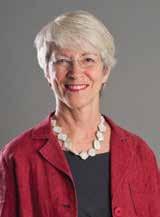
2 BELLWETHER SPRING 2016 FROM THE DEAN
C. Hendricks, V’79, GR’80
The
Gilbert S. Kahn Dean of Veterinary Medicine
“Why are you here?”
“I’ve come to realize why I’ve spent my entire veterinary career at Penn Vet, and perhaps why students also like it so much: If you can dream it, you can do it here.”
OFFICE OF ADVANCEMENT, ALUMNI RELATIONS, AND COMMUNICATIONS
Assistant Dean of Advancement, Alumni Relations, and Communications
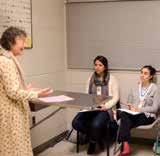
Carol Pooser
Director of Alumni Relations
Kristen McMullen
Director of Communications
Ashley Berke
Director of Annual Giving and Advancement Services
Mary Berger
Director of Development for Companion Animals
Helen Radenkovic
Director of Development for New Bolton Center
Margaret Leardi
Director of Development and Board Relations
Jillian Marcussen
Web Communications Manager
Carole Cloud
Communications Specialist for New Bolton Center
Louisa Shepard
Associate Director of Major Gifts
Neva Graham
Assistant Director of Institutional Events
Brittany Tinsley
Assistant Director of Annual Giving and Advancement Services
Barbara Belt
Communications Coordinator
John Donges
Advancement Services Coordinator
Sarah Trout
Administrative Assistant
Kathleen Murray
Financial Coordinator
Joan Cerceo
Editor
Karen Gross
Contributors
Sacha Adorno
Katherine Unger Baillie
Mary Berger
Ashley Berke
John Donges
Karen Gross
Jillian Marcussen
Kristen McMullen
Louisa Shepard
Brittany Tinsley
Charlene Wandzilak
Designer Anne Marie Kane
Please address your correspondence to:
Ashley Berke University of Pennsylvania
School of Veterinary Medicine
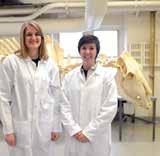
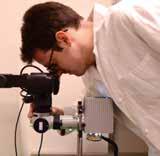
3800 Spruce Street Philadelphia, PA 19104-6010
(215) 898-1475
berke@vet.upenn.edu
None of these articles is to be reproduced in any form without the permission of the School.
© Copyright 2016 by the Trustees of the University of Pennsylvania. The University of Pennsylvania values diversity and seeks talented students, faculty and staff from diverse backgrounds. The University of Pennsylvania does not discriminate on the basis of race, sex, sexual orientation, gender identity, religion, color, national or ethnic origin, age, disability, or status as a Vietnam Era Veteran or disabled veteran in the administration of educational policies, programs or activities; admissions policies; scholarship and loan awards; athletic, or other University administered programs or employment. Questions or complaints regarding this policy should be directed to:
departments 2 Dean’s Message 24 Class of 2019 By the Numbers 25 Events 26 White Coat Ceremony 28 Research Brief 34 Campus Updates 36 Faculty, Staff, & Student News 43 New Overseer 50 Alumni News 56 Calendar WWW.VET.UPENN.EDU/BELLWETHER 3
Executive Director, Office of Affirmative Action and Equal Opportunity Programs, Sansom Place East, 3600 Chestnut Street, Suite 228, Philadelphia, PA 19104-6106 or by phone at (215) 898-6993 (Voice) or (215) 898-7803 (TDD). features 4 VMD-PHD PROGRAM LEADS IN TRAINING 12 ADVANCING VETERINARY EDUCATION 16 MAKING PENNSYLVANIA PROUD 19 STUDENT SPOTLIGHT 30 FRIENDS SUPPORT FUTURE VETS 32 A FATHER’S GIFT TO VITE LAB 46 A PENN VET FAMILY TREE GROWS SPRING 2016 #85 THE MAGAZINE OF PENN VET 12 4 about the cover First-year students (from left) Bryan Hatton, Therese Langan, and Agatha Kuza were photographed in the anatomy lab examining the leg bones of a horse. Photo by John Donges 16 bellwether contents BELLWETHER HAS BEEN DIGITIZED! You can now read Bellwether back issues dating to the magazine’s beginnings in 1981. Visit repository.upenn.edu/bellwether
Penn Vet’s VMD-PhD Program
Leading the way in training tomorrow’s veterinarian-scientists
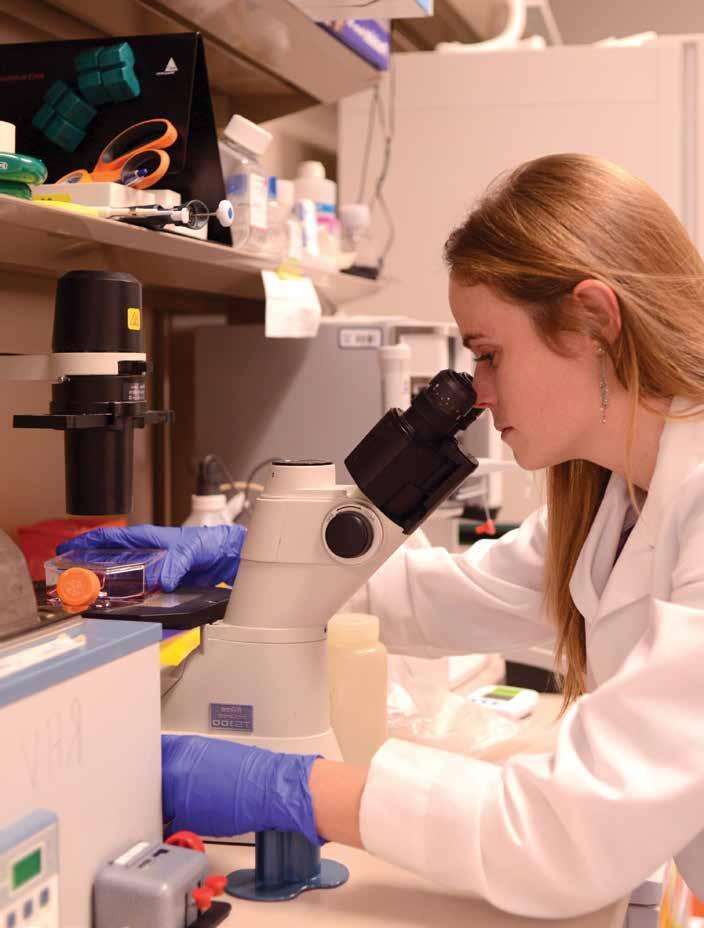 BY KATHERINE UNGER BAILLIE
BY KATHERINE UNGER BAILLIE
4 BELLWETHER SPRING 2016
Penn Vet’s VMD-PhD Program, which trains students to be both veterinarians and scientists, attracts passionate and brilliant students who commit to an average of eight years honing their research and clinical skills. Ultimately, they find themselves well equipped to be leaders in their chosen fields, including academia, biotechnology and pharmaceutical industries, government agencies, and more. And with a growing focus on the concept of One Health—recognizing the connections between human, animal, and environmental health—veterinarian-scientists are in great demand.
A Pioneering Program
From its very start, the dual-degree program was imagined as a world-class training ground. Dr. Ralph Brinster, a pioneer in reproductive biology, was the program’s founding director, launching it in 1969 with support from Penn Vet’s Dean at the time, Dr. Mark Allam. To kick off the program financially, they applied for and received support from a Medical Scientists Training Program (MSTP) grant from the National Institutes of Health (NIH).
“The same innovative spirit and creativity that led Ralph Brinster, under Dean Allam’s leadership, to pursue the NIH grant to found the program in the first place, characterized the program and fostered these qualities in the trainees,” said Penn Vet Dean Joan Hendricks, who earned her VMD and PhD through the program in 1980.
role that calcium signaling plays during viral budding. “Ultimately, our understanding of how viruses can hijack host proteins and manipulate cellular signaling pathways will allow us to develop better therapeutic agents to treat infection by many viruses, including Ebola virus,” Madara said.
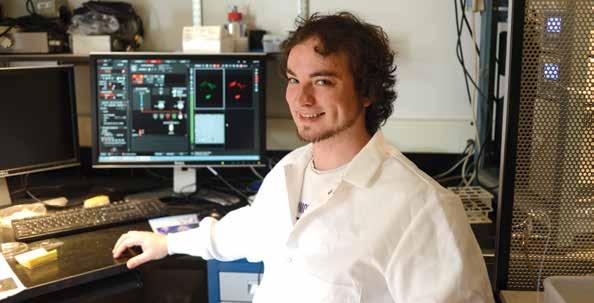
WWW.VET.UPENN.EDU/BELLWETHER 5
Completing a veterinary degree—with four years of intensive classwork, clinical rotations, surgeries, community outreach, and more—takes perseverance. So does earning a PhD. It takes exceptional dedication to do both.
VMD-PhD student Jonathan Madara is studying a fluorescently tagged version of the Ebola virus matrix protein, VP40 (seen on the computer screen in green), and the host cellular protein Alix (in red). In the lab of Penn Vet’s Dr. Bruce Freedman—in collaboration with the lab of Dr. Ronald Harty— Madara is helping determine the
Though MD-PhD programs were available and catching on, Brinster and other leaders had a prescient intuition that veterinary science was a field on the brink of blossoming. They believed that well-trained students, with a firm command of both medicine and hard-hitting scientific research, would have important roles to play in society.
“Dr. Brinster’s view was that there would be no watering things down, no scrimping on the PhD,” said Dr. Michael Atchison, current Director of the VMD-PhD Program and Professor in the Department of Biomedical Sciences at Penn Vet. “The goal was to produce outstanding scientists.”
Penn’s medical school also had its own MSTP grant until 1979, when the NIH said that Penn could only have one. Since then, Penn Medicine and Penn Vet have shared one MSTP grant, though the vet school now also has assistance from a second NIH grant through the National Institute of Allergy and Infectious Diseases, as well as support from the Dean’s office, scholarships, and other sources.
In its 47 years of existence, the program has had only four directors. After Brinster, program alumni Drs. Richard Miselis and John Wolfe followed as leaders. Atchison has been director since 2001.
“These are brilliant, high-flying students, and it’s a lot of work but also an honor to support them,” Atchison said.
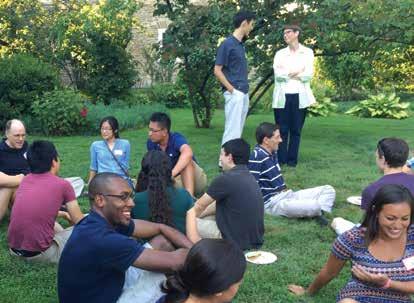
A “Synergy” of Science and Medicine
Certainly many students in veterinary school excelled in science leading up to their professional degree, and many PhD students may have an interest in animal medicine. But Atchison says successful dual-degree students have passions that distinguish them.
“They must have a drive to be scientists,” he said. “That almost has to be their numberone passion because doing science is hard and it’s a long program. And, of course, they also need to love veterinary medicine, and going through vet school is no easy feat either.”
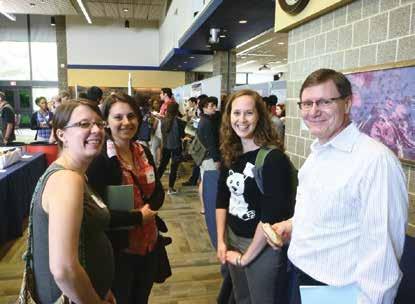
6 BELLWETHER SPRING 2016
(Left photo) Dr. Lawrence (Skip) Brass, Professor of Medicine and Pharmacology in the Perelman School of Medicine, hosted a welcome picnic for incoming MD-PhD and VMD-PhD students.
(Right photo, pictured from left to right) Sondra Calhoun, Bailey Baumann, Abigail Shearin, and Dr. Michael Atchison at the 2015 Combined Degree Retreat.
The program is designed so that students always have a foot in both science and medicine.
“They are working toward both degrees all the time, but at different times they’re working more on one than the other,” Atchison explained.
He described the structure as a vet school-grad school-vet school sandwich. Students begin with a full veterinary curriculum for two years. During the summer months in between, they rotate through labs in their graduate groups of choice to help them identify which will become their home base during their PhD. Then, they transition into their PhD coursework and research. Once they have finished and defended their dissertation, they return back to the vet school full time to fulfill the clinical requirements of the VMD degree.
This interwoven approach is intentional. “When you’re doing medicine you’re thinking science, and when you’re doing science you’re thinking medicine,” Atchison said, adding that, “By intertwining them in this way, there is synergy.”
According to current VMD-PhD student Sylvia Qu (see Research Brief, page 28), taking the core veterinary courses before embarking on PhD work in bioengineering and orthopedic surgery was an asset.
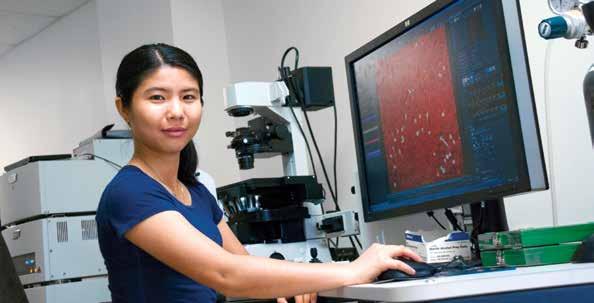
“I was exposed to everything from anatomy and physiology to more specific classes like orthopedics and surgery, which really smoothed my transition to the engineering school where I worked with surgeons every week,” Qu said. “Looking at translational animal models was very comfortable for me at that point.”
Each student meets with Atchison formally at least once a year and again with another advisor in the program. Atchison noted that he gives informal advice far more often than that, helping students weather the ups and downs of scientific research and coursework demands. He and the other leaders of the dual-degree program, including Drs. Nicola Mason, Susan Volk, Bruce Freedman, and Michael May, organize lectures, career development panels, and other professional development workshops for the students to hone their skills in grant writing and presenting their work.
WWW.VET.UPENN.EDU/BELLWETHER 7
Sylvia Qu views cell images taken with a confocal microscope visible in the background. To learn more about VMDPhD student Sylvia Qu, see the Research Brief on page 28.
An Unparalleled Environment
Atchison isn’t shy about extolling the virtues of Penn’s program, such as the strength of the University’s biomedical research. The University is consistently in the top three academic recipients of NIH funding and is home to 600 research laboratories. Penn Vet also has the only VMD-PhD program with dedicated NIH funding.
“Most vet schools aren’t in that type of environment,” Atchison said.
Penn’s notable embrace of interdisciplinary research means that graduate groups span across schools, providing a path for students to find the mentor best suited for their interdisciplinary work.
In addition, Penn Vet’s Ryan Hospital and New Bolton Center hospital have significant caseloads, with more than 34,000 patient visits a year from which the students can learn— not to mention renowned faculty engaged in cutting-edge research in a range of basic and applied science disciplines.
Furthermore, the program is able to offer a compelling financial package to VMD-PhD students: their tuition is free, and they receive a stipend equivalent to other biomedical science PhD students. For those reasons, when Atchison makes an offer to come to Penn, applicants rarely say no.
Reaching Across Schools
Most students wind up pursuing their PhD in one of Penn’s nine Biomedical Graduate Studies groups, which span the University’s schools and focus on fields such as immunology, epidemiology, biochemistry, and cell biology.
“Faculty love having combined-degree students in their labs,” Atchison noted.
Most often, students pursue their doctoral degrees with a faculty member in the School of Medicine, but students have also partnered with professors in the School of Arts & Sciences, the School of Engineering and Applied Science, and even the School of Design (on a project looking at how urban planning can improve food flow through cities). And, of course, many study under faculty at Penn Vet.
“We’re lucky that Penn is an interactive place that emphasizes interdisciplinary work,” Atchison said. “The goal is to keep the walls and barriers low.”
VMD-PhD students also meet monthly with MD-PhD students—“kindred spirits,” as Atchison calls them—to share their work in a “Grand Rounds” format, presenting a clinical case and then discussing the basic science that underlies it. Additionally, the VMD-PhD and MD-PhD program participants have a shared annual retreat each summer, where students report on their research progress and learn about clinical specialties.
Through nearly a decade of intensive schooling, a support system is essential. The VMDPhD Program encourages community and camaraderie, including a night out on the town to welcome new students to the program, a yearly barbecue, a holiday dinner at Atchison’s home, and spontaneous outings throughout the year.
“The VMD-PhDs are a close-knit group,” Qu said.
Making an Impact
The dual degree also gives VMD-PhD students the combination of in-depth molecular medicine, whole animal biology, and understanding of multiple species that a VMD or a PhD student may not have without the other degree. Their uniquely robust skill set readies VMD-PhD students for careers in a plethora of fields.
8 BELLWETHER SPRING 2016
Atchison noted that VMD-PhD students have excelled in infectious disease research. Because roughly three-quarters of new infectious diseases found in humans have their origins in animal species—illustrated by Ebola, SARS, and West Nile outbreaks, to name a few—a veterinary perspective and deep understanding of zoonotic disease transfer can be crucial for public health response efforts as well as addressing epidemiology, biosafety, and bioterrorism issues.
Similarly, a nuanced understanding of comparative biology makes VMD-PhD students uniquely qualified for careers in biomedical research. Many have gone into careers in cancer biology, helping translate research in animal models to humans.
The success of the program’s 73 graduates to date is backed up by rigorous tracking, facilitated by a biannual newsletter to maintain the sense of community in the program. Describing the majority of graduates, Atchison said, “They’re veterinary scientists in either academia, biotech and pharma, or the government, and many tend to be in high-level positions.”
Indeed, at least a third of those in academia—graduates’ most common career track— are in leadership positions, such as chairs or chiefs of departments. Of those in the pharmaceutical or biotechnology industries, more than half are presidents, chief executives, or vice presidents of their companies. Several in government agencies also serve in top positions. Many have found successful homes at Penn Vet, including Dean Hendricks.
“As one of the early graduates of the VMD-PhD Program, I tremendously enjoyed the freedom to explore the remarkable strengths of Penn’s biomedical community without constraints,” she recalled. “In all facets of the education and training there was rigor, encouragement to think for ourselves, and applause if we showed independent thought processes.”
The latest crop of students is already making a mark in fields ranging from cancer biology to engineering.
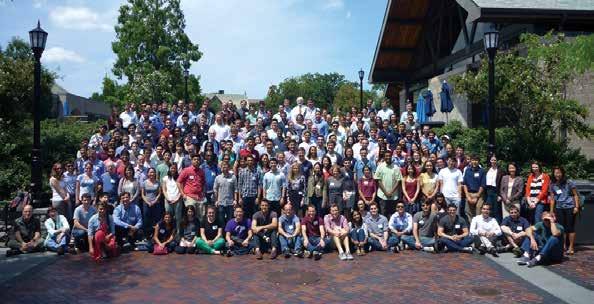
Graduate Nikkita Patel, who finished the program last year, pursued her PhD in epidemiology, working with advisor Dr. Gary Smith, Professor of Population Biology and Epidemiology at Penn Vet. She published some of her thesis research in Proceedings
Atchison isn’t shy about extolling the virtues of Penn’s program, such as the strength of the University’s biomedical research. The University is consistently in the top three academic recipients of NIH funding and is home to 600 research laboratories. Penn Vet also has the only VMDPhD program with dedicated NIH funding.
WWW.VET.UPENN.EDU/BELLWETHER 9
Penn’s MD-PhD and VMD-PhD students posed for a group photo at the 2015 Combined Degree Retreat at Villanova University. The event included student talks, poster presentations, and a keynote speaker.
“I chose to enroll in the dual-degree program because I wanted to fulfill my childhood dream of becoming a veterinarian. But I also wanted my veterinary career to impact the health of people.”
Rebecca Evans (pictured
of the National Academy of Sciences—one of the world’s most-cited and comprehensive multidisciplinary scientific journals—on using network analysis to track the countries most intensely tied to webs of wildlife trafficking.
Laurel Redding, who also completed the program in 2015, traveled to the northern highlands of Peru as part of her PhD research. She interviewed smallholder farmers and monitored dairy cow herds in order to understand antibiotic use and the resulting safety of milk products. She found that while farmers were aware of the risks of antibiotic use, the vast majority continued to sell tainted milk, highlighting a need for accountability and incentives for the individual producers.
Back on campus, several students have recently defended their theses successfully, or are on the cusp of doing so.
Rebecca Evans, who received a full pass on her defense in November, worked with her advisor, Penn Medicine’s Dr. Robert Vonderheide, to investigate the role of the immune system in combating pancreatic ductal adenocarcinoma—a notoriously difficult-to-treat cancer.
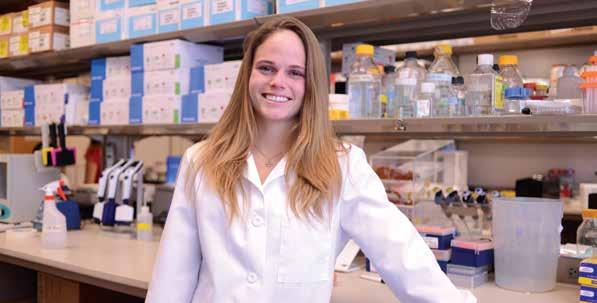
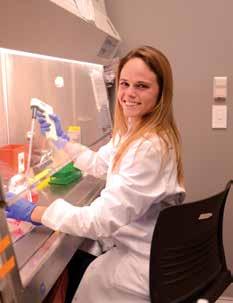
“I chose to enroll in the dual-degree program because I wanted to fulfill my childhood dream of becoming a veterinarian. But I also wanted my veterinary career to impact the health of people,” Evans said. “Cancer biology is an excellent platform for translational research because human and animal cancers share the same pathophysiology. So, cross-talk between veterinarians and physicians could greatly facilitate the development of new treatments.”
Jeffrey Carey is in the midst of his doctoral work on how bacteria regulate gene expression to anticipate changes in their environment. He hopes to defend his dissertation later this year.
“I’m particularly interested in the regulation of respiratory pathways, which need to be properly coordinated with fluctuations in nutrient availability in order for bacteria to survive and thrive in complex environments,” such as the gut of a host, Carey explained.
Advised by Dr. Mark Goulian, Professor in the School of Arts & Sciences’ Biology and Physics & Astronomy departments, Carey brings a unique perspective to his research. “Being in the combined-degree program has given me a background in animal physiology and pathology that’s been valuable in formulating the basic microbiology questions I try to address in lab,” he said.
10 BELLWETHER SPRING 2016
above)
A Growing Need, An Expanding Program
The National Academy of Sciences has published several reports demonstrating an acute national shortage of veterinarian-scientists needed for industrial, academic, and government positions.
Coming up on a half-century of existence, the VMD-PhD Program continues to grow to meet this demand. Program participation has doubled since 2002, with 22 students currently enrolled.
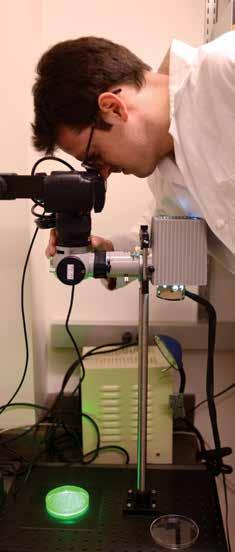
“We knew we were doing a good job of producing successful graduates,” said Atchison. “It made sense to build the program so we had a critical mass on campus and also helped meet the societal need for veterinarian-scientists.”
Applicant numbers are at an all-time high, with nearly 50 per year. The admission process remains highly competitive, with about three to four students accepted each year.
To build on the program’s success, Atchison is working with colleagues at other universities to help them improve or grow their own combined-degree programs. His hope is that NIH begins to support more than just the Penn program.
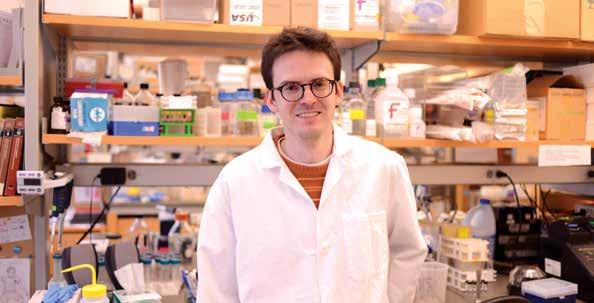
“More and more, there is a recognition of how important veterinary-scientists are,” Atchison said. “I’m hopeful that along with this recognition will come more support to put these innovative minds to work around the country.”
OUR SUPPORTERS
In addition to NIH funding, which covers part of the total cost of the program, the VMDPhD Program has thrived due to the generous support of Mindy and Andrew Heyer, Drs. Francine and Barnett Rattner, Mark and Tracy Spitzer, the Armour Lewis Family Foundation, and Penn Vet alumni. Increasing endowment resources for the program remains a priority for the School. For information, please contact Jillian Marcussen, Director of Development, at 215-898-4235 or jillian2@vet.upenn.edu.
WWW.VET.UPENN.EDU/BELLWETHER 11
VMD-PhD student Jeffrey Carey is focused on how bacteria regulate gene expression to anticipate changes in their environment. The camera setup is a house-built system for imaging fluorescent bacterial colonies on agar plates.
ADVANCING VETERINARY EDUCATION
BY KAREN GROSS
FOUNDED IN 1884, PENN VET IS THE FIRST VETERINARY SCHOOL BORN FROM A MEDICAL SCHOOL—HENCE ITS SINGULAR VETERINARIAE MEDICINAE DOCTORIS (VMD) DEGREE. AND, IN 1969, PENN VET WAS THE FIRST TO SHIFT AWAY FROM TRADITIONAL, LOCKSTEP VETERINARY TRAINING TO A UNIQUE CORE-ELECTIVE CURRICULUM, WHICH ENCOURAGES STUDENTS TO EXPLORE THEIR INTERESTS, FOCUS ON MAJORS, AND EVEN PURSUE A DUAL DEGREE.
Today, change is again afoot as Penn Vet examines the way it trains both students and faculty. With the recent appointments of Dr. Kathy Michel and Dr. Mary Bryant—as Associate Dean of Education and Executive Director of the Office for Students, respectively—the School is developing new ways to ensure excellence in veterinary education while supporting overall student well-being.
Additionally, with an accreditation review this year, “There’s an opportunity to say, ‘Are we doing the best we can?’ So, we’re trying to embrace it that way,” said Penn Vet Dean Joan Hendricks.
EDUCATING EDUCATORS
Dr. Kathy Michel is approaching her 30th year at Penn Vet, and she’s known as a trailblazer. As Penn Vet’s only small animal clinical nutritionist, she created the School’s
curriculum for that field. She is also responsible for bringing communications training to the curriculum beginning in 2006.
“Curricular design and education have always been interests of mine,” she said.
Named Associate Dean of Education in January 2014, Michel is charged with assessing Penn Vet’s curriculum, creating professional development opportunities for faculty, and ensuring that the School maintains its accreditation by the American Veterinary Medical Association Council on Education. To help inform her work in this important role, she completed a master’s degree in medical education last year from Penn’s Graduate School of Education—all while maintaining her duties as Professor of Nutrition.
Michel knows first-hand that, even if a veterinarian is a leader in her field, she may not be trained in the fundamentals and best practices of teaching.
12 BELLWETHER SPRING 2016
“There’s no question that our faculty are very committed to doing the best job they can at being educators,” Michel emphasized. “One of my goals is to give [faculty] the professional foundations for becoming good educators, or taking their expertise as educators to the next level. Whether it’s a lecture, a laboratory, or an entire course, they need fundamentals to help them design it to be the most effective at conveying whatever knowledge and skills are appropriate for the training of our students.”
Despite very busy schedules—which often involve research and clinical duties, along with teaching—Penn Vet educators have been embracing new opportunities to learn these fundamentals as well as innovations. Last year, Michel organized a professional development seminar series for faculty in conjunction with Penn’s Center for Teaching and Learning, as well
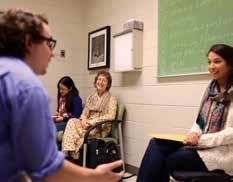
as a summer retreat. Topics included the creation of learning objectives, assessment of learning, active learning in lectures, peer observation strategies, and controversies of using lecture capture. There were workshops on instructional technologies and opportunities for faculty to share teaching strategies that they have found effective. Among the attendees was Dr. Ray Sweeney, Chief of the Section of Medicine and Ophthalmology in the Department of Clinical Studies at New Bolton Center. A Penn Vet educator since 1982, he has garnered a remarkable 19 teaching awards including the SCAVMA Excellence in Teaching Award (five times), the Norden North American Outstanding Teacher Award, and the Lindback Award for Distinguished Teaching. Although he’s a seasoned educator, “I’m always trying to get better,” said

WWW.VET.UPENN.EDU/BELLWETHER 13
(Top photo) Dr. Kathy Michel preps third-year students before they interact with a simulated client as part of veterinary communications training. From left to right are Dr. Michel, Arielle Thomas, Sabrina Katz, Yukwah Kwok, and Rachael Nelson.
(Bottom photo) Dr. Michel observes as Arielle Thomas receives feedback from the “client.”
Sweeney, who attended the entire faculty seminar series.
He spoke by phone along with wife Dr. Corinne Sweeney, Associate Dean for New Bolton Center, who over the past four decades has also received numerous teaching honors including the Executive Board of Alumni’s Excellence in Teaching Award and the Lindback Award.
She attended last summer’s educational retreat for faculty. “It’s been refreshing and exciting to have someone bringing to the faculty and the School some methodologies, opportunities, and science to the teaching part of what we do,” she said.
The Sweeneys are known for different teaching methods; she provides thorough handouts, while he uses the blackboard and chalk. Yet, he quipped, “I always make Corinne listen to all my jokes before I tell them in class.”
According to Dr. Rose Nolen-Walston, Associate Professor of Large Animal Internal Medicine, “Ray Sweeney has been the most remarkable teaching and personal mentor. He creates an ambience of collegiality and respect. I think that type of role model changes the whole way a hospital works and creates an environment where it’s safe and easy to learn.”
Nolen-Walston received the coveted Lindback Award for 2013-2014. “It was such a remarkable feeling. And it almost felt like a set of shoes I had to grow into. It felt as much inspiring as rewarding.”
She is known for infusing humor and case-based role-playing into the classroom.
“I want to cultivate independent, analytic, scientific problem-solvers, not just users of cookbook approaches,” she said. “West Nile virus was first identified by a vet. That was something truly novel, and you can’t solve that by reading a book or looking it up.”
She called the new professional development opportunities for faculty “fantastic,” noting, “Kathy [Michel] is doing an outstanding job offering programs we never had before.”
STUDENT DEVELOPMENTS
Students ultimately reap the benefits of effective teaching, as well as courses designed to be cohesive and compelling. At Penn Vet, students are also benefitting from curriculum developments such as veterinary communications training with simulated clients.
A decade ago, Michel integrated communications training into the curriculum as part of the Introduction to Clinical Veterinary Medicine (ICVM) course series. In 2012, simulated clients were added to the required first- and third-year labs.

“I reached out to the School of Medicine, where they had been using simulated patients for many years. They helped us create cases with trained actors to play clients,” Michel said.
In the first-year ICVM lab, students work on core communications skills such as taking medical history. In the third year, students practice more advanced communication skills involving diagnosis and treatment.
14 BELLWETHER SPRING 2016
Distinguished Penn Vet educator Dr. Raymond Sweeney lectures students at New Bolton Center. Although he has won numerous teaching awards, Sweeney says he is “always trying to get better.”
“The ‘client’ may be upset, angry, or in shock, and the student has to be able to answer the client’s questions and help decide what kind of treatment they are going to pursue,” Michel explained.
In each two-hour lab there are four students, instructed by a trained faculty or alumni communications coach. The client/ actor is also trained to provide feedback.
“The students love it. And what really pushed it to the next level was to be able to train a whole bunch of faculty and alumni on communication skills and the basics of coaching,” Michel said. Early on, she had to raise around $40,000 to bring in an outside training workshop for the coaches.
Now overseen by Dr. Erika Krick, Assistant Professor of Oncology, Penn Vet’s communications program has grown sophisticated enough to train its own coaches. There are around a dozen faculty and alumni participants, and “the people who are involved get so much out of the experience,” Michel said.
Another exciting development is Penn Vet’s state-of-the-art Electronic Medical Records (EMR) system known as VISION, which went live in several Ryan Hospital and New Bolton Center laboratories last fall. In addition to integrating client, patient, and research information, the EMR is intended to serve as an important tool for student learning.
Michel is developing a rubric for educators. “The person who’s reading the student’s work in the EMR will be able to evaluate that competency and then provide feedback,” she said.
Also on the horizon is a new Clinical Skills Lab, expected to open this year. “We are envisioning it as a drop-in space, where there will be a variety of models for students to practice all kinds of clinical skills,” Michel explained. Those might include surgical skills, drug and fluid administration, anesthesia, and animal handling—allowing the students to practice with models and develop basic skills before they work with a live animal.
BEYOND THE CLASSROOM
Last fall, The Washington Post highlighted how veterinary schools are addressing the unique stressors faced by veterinarians, such
as the emotional toll of euthanasia. The article cited a troubling CDC report, which revealed that veterinarians experience suicidal thoughts at a significantly higher rate than the average population.
Penn Vet is working to address such issues. As part of the ICVM series, students discuss euthanasia with a bereavement counselor and both small and large animal veterinarians. The goal is to avoid burnout and better communicate with clients about the end of life.
The School has also expanded its relationship with Penn’s Counseling and Psychological Services (CAPS) center. As of last fall, a CAPS counselor is onsite two nights a week. (For more information about CAPS counselor Dr. Dana Lehman, please see page 42.)
This arrangement—unique among Penn’s professional schools—was originally brokered by Michel and has blossomed under the leadership of Dr. Mary Bryant, who was appointed last May.
“Part of the education should be how you cope with stress. We need to give students coping and anti-anxiety skills. It’s important to know where your resources are,” Bryant said.
An accomplished Penn Vet graduate, Bryant has taught a career development class at the School for nearly 15 years. She has a unique window into the pressures students face. In fact, it was a student wellness survey that drove increased access to mental health services.
In her newly created position, Bryant oversees the recently consolidated Office of Admissions and the Office of Student and Curricular Affairs. In addition to encouraging student input, she’s open to staff ideas—for instance, renaming the Office of Students as the Office for Students. “When I first started, we had a team-building retreat for the new combined offices, and it was they who suggested the name change,” she said, joking that they may possibly rename it again as the “Office of Happiness.”
She considers it her job to “make sure students have an awesome experience” at Penn Vet. And she firmly believes that the Penn Vet faculty shares the same goal.
“The faculty is absolutely studentcentered. They are here to make sure students succeed,” she said.
CALLING ALL FACULTY AND ALUMNI!
If you are interested in becoming a veterinary communications training coach, please contact Dr. Kathy Michel at michel@vet.upenn.edu
WWW.VET.UPENN.EDU/BELLWETHER 15
“Part of the education should be how you cope with stress. We need to give students coping and anti-anxiety skills. It’s important to know where your resources are.”
—�Dr. Mary Bryant
MAKING PENNSYLVANIA PROUD
MEET THE RECIPIENTS OF THE INAUGURAL COMMONWEALTH ONE HEALTH SCHOLARSHIPS
BY LOUISA SHEPARD
Allyson Anderson and Amy Kraus met in a farm animal reproduction class at Penn State. Now, they are both members of Penn Vet’s Class of 2019.
The two Penn State graduates, both from small towns in rural Pennsylvania, intended to pursue veterinary careers caring for livestock and farm animals, specifically dairy cows. They were leaning toward out-of-state schools including Cornell, Wisconsin, and Purdue.
But then came the call from Penn Vet admissions: Would you reconsider if you received a full scholarship to cover the tuition?
In that case, yes.
Recognizing potential to the School, to the veterinary profession, and to Pennsylvania agriculture, the Commonwealth One Health Scholarship provides students a full tuition subsidy, at $50,000 a year, for four years at Penn Vet—Pennsylvania’s only veterinary school.
The School has allocated scholarship funds for the Commonwealth One Health Scholarship, which specifically targets Pennsylvania residents who have demonstrated a genuine interest in livestock medicine and plan to practice in Pennsylvania.
“Allyson and Amy were selected from a group of highly competitive applicants, and
we look forward to watching them proudly serve Pennsylvania’s agriculture industry,” said Penn Vet Dean Joan Hendricks. “We are thrilled to offer an array of scholarships to recruit the best and brightest to Penn Vet, and decrease the burden of student debt.”
ALLYSON ANDERSON
Coudersport is a tight-knit town of about 2,500 people in north central Pennsylvania’s Potter County. Allyson Anderson’s grandparents operated a dairy farm there, eventually dividing the land among their children, including her parents.
“All my parents’ siblings live within a half hour,” said Anderson, 22. “My mom’s maiden name was Long, and we live on Long Road.”
Crazy about horses, Anderson started to ride when she was seven years old. Her dad put up miles of fence for her horses, including a Quarter Horse named Flash, which she showed 4-H riding Western. Her mom would help her take care of them, and her farmer cousin would throw off hay when he went by with the truck, no charge.
“I am so thankful for the giant support system I have with my family,” Anderson said.
16 BELLWETHER SPRING 2016
Although she always wanted to be a veterinarian, she decided to pursue a degree in chemical engineering, going her freshman year to the Rochester Institute of Technology. But she couldn’t let go of her dream of working with animals, and transferred to Penn State to pursue a degree in veterinary and biomedical sciences with the intention of applying to veterinary school.
During those undergraduate years she worked weekends and summers at a dairy, Rissdale Farm. “I fed the calves and took care of them, gave them their injections and medications right after they were born,” she said, adding that she also “milked and scraped manure, those less-glorious jobs.”
Anderson graduated a semester early and worked at the family’s mill, Elliott Lumber Co. Undecided, with a noon deadline looming, she emailed Penn Vet’s admissions department to say no, she was not interested in coming for an interview. On her next break from running a chop saw, she saw several missed calls from Mac Keiter, Penn Vet’s former Associate Dean for Admissions. When she called back, he told her about the scholarship.
“Mac was very helpful, and very welcoming,” she said.
Even though she was “terrified” of Philadelphia, Anderson also reconsidered Penn Vet when her mentor, Dr. Sally Fowler, encouraged her to apply. “When I interviewed I was so glad I saw New Bolton Center. It is very impressive,” she said. “I knew I could manage if I could be out there some of the time.”
Anderson is more than managing. The former Allyson Elliott was married last summer to Dustin Anderson, and the couple lives in Exton, Pennsylvania, with their chocolate Labrador, Mayah, and Tuxedo kitten, Brandi. She takes the train into Philadelphia for classes during the week, and spends some weekends at New Bolton Center with the Food Animal Club.
The Andersons plan to return to Coudersport once she graduates, and she expects to work in a practice with an emphasis on large animals. “I am definitely committed to food-animal medicine,” Anderson said, noting that she is especially interested in dairy reproduction.
Her only concern about being a woman in livestock medicine is her diminutive, five-foot-four-inch frame. “I’ll be standing on a lot of milk crates,” she said, laughing.

WWW.VET.UPENN.EDU/BELLWETHER 17
“When I interviewed I was so glad I saw New Bolton Center. It is very impressive.”
—�Allyson Anderson
Amy Kraus (at left) and Allyson Anderson were classmates at Penn State before receiving the inaugural Commonwealth One Health Scholarships to attend Penn Vet.
AMY KRAUS
Living in the middle of two dairy farms definitely influenced Amy Kraus, who grew up in Aliquippa, Pennsylvania, near the Ohio border in rural Beaver County outside of Pittsburgh.
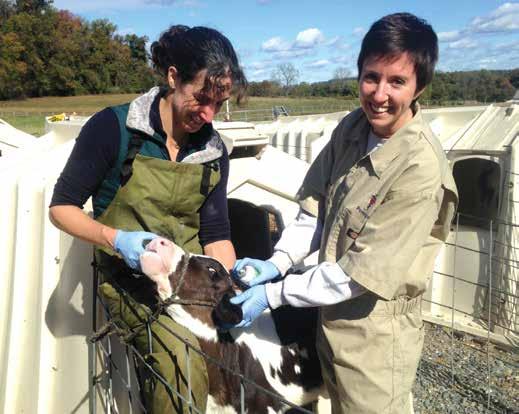
Neighbor Ed Brunton, who owns one of the few dairies that still bottles its own milk and runs a home delivery service, taught her how to milk cows.
“In preschool I knew I wanted to have a job working with animals,” Kraus said, adding that her grandfather was a dairy farmer, who left the family farm to work in Pennsylvania’s steel mills. “My parents say it must be in my genetics.”
Kraus showed her Quarter Horse, Hop Scotch, in 4-H, and her high school senior career project was veterinary medicine.
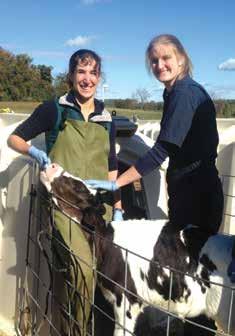
In the Schreyer Honors College at Penn State, she pursued a degree in animal science and completed a thesis in metabolomics. This is a relatively new field focused on studying the small molecules left behind in biofluids such as milk and urine. She analyzed equine urine, looking at biomarkers for gastrointestinal damage, which can be related to colic, laminitis, and equine metabolic syndrome. While working at the Penn State Dairy Barns, she also assisted in nutrition research trials to study milk fat depression.
Kraus was a member of Penn State’s championship teams in the National
Collegiate Beef Quiz Bowl and the American Dairy Science Association Quiz Bowl. “I was usually in charge of knowing facts about disease, nutrition, and reproduction in cattle,” she said.
During spring break her junior year, Kraus participated in an externship at New Bolton Center, shadowing Dr. Raymond Sweeney, Chief of Medicine, and fourthyear students.
“I saw a down cow floated in an Aqua Cow for the first time,” she said. “I really loved all the professors. It was so interesting to see the advanced procedures and options available.”
Even though she had scholarship offers from other vet schools, and had canceled her Penn Vet interview, a call from Keiter about the full scholarship changed her mind.
“I’m excited to be at Penn,” said Kraus, 23. “I think Pennsylvania has a great climate for raising dairy cattle, and I would love to stay in Pennsylvania to promote our own dairy industry.”
Kraus said she is firmly committed to working in dairy and plans to pursue an internship in dairy reproduction this summer.
“I am thinking of working for an all-dairy practice to gain practical experience in the field, and then perhaps pursuing a residency and conducting research,” she said, adding, “Maybe I will teach at a veterinary school someday.”
“I’m excited to be at Penn. I think Pennsylvania has a great climate for raising dairy cattle, and I would love to stay in Pennsylvania to promote our own dairy industry.”
—�Amy Kraus
(Pictured above) Amy Kraus, at right, was photographed working at New Bolton Center’s Marshak Dairy with Dr. Meggan Hain, Staff Veterinarian in Field Service.
18 BELLWETHER SPRING 2016
(Pictured at right) Allyson Anderson, at right, also collaborates with Hain at Marshak Dairy.
STUDENT SPOTLIGHT
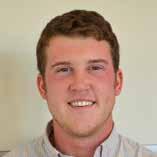
MEET FOUR PENN VET STUDENTS


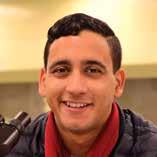
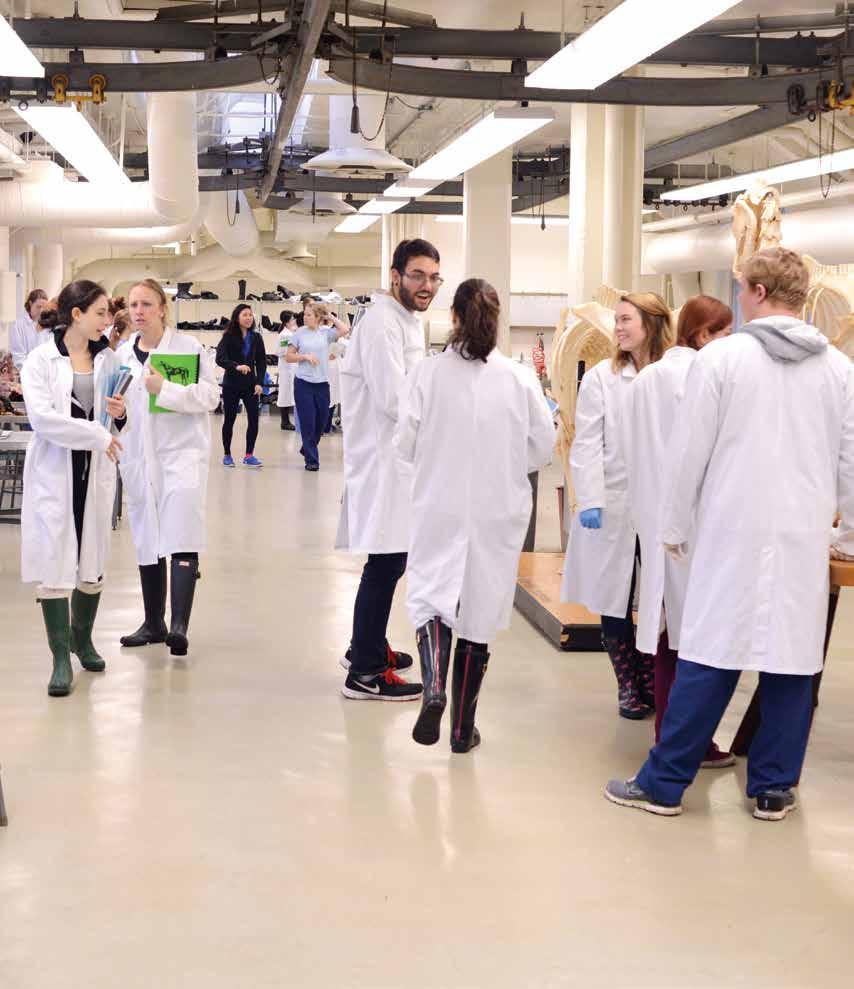
FOLLOWING THEIR OWN UNIQUE PATHS
BY LOUISA SHEPARD
WWW.VET.UPENN.EDU/BELLWETHER 19
Working at the Philadelphia Animal Hospital one summer, Felipe Garcia realized his path in a veterinary medicine career. A client came in who spoke only Spanish, and he instinctively offered to step in and translate.
Growing up in Miami, Garcia was the translator for his single mother, an immigrant from Mexico. She relied on her only child to help her navigate the Englishspeaking world.
“I realized that is something I can offer, since Spanish is my first language, to make sure that the language barrier does not stand in the way of care for a pet,” said Garcia, president of the Penn Vet Class of 2019. “It’s like a calling to help the people and animals where I grew up, a niche I can fill to give back to the community.”
That same summer, before his junior year at Hamilton College, Garcia was at Penn Vet participating in Summer VETS—a oneweek program to give university and high school students hands-on experience at a vet school.
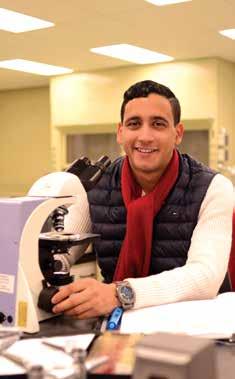
“I knew after that summer that this is what I wanted to do with my life,” Garcia said. “Penn was the only veterinary school I applied to. I was really set on Penn, primarily because of the Summer VETS program.”
Garcia is most interested in small animal medicine, and perhaps a specialty in surgery. “I am impressed with the caseload at Ryan Hospital and the focus on research,” he said.
Now 23, Garcia said he has always loved animals, collecting “animal facts” cards as a child and watching shows on the Discovery Channel and Animal Planet. The summer after graduating from Coral Gables High School, he worked at the Jungle Island zoological park in Miami, helping the veterinarian.

“For me it didn’t feel like work,” he said. “I knew working with animals was something I wanted to pursue.”
A standout in the large, public high school, Garcia was on the Dean’s List, in the National Honor Society, and held the rank of captain in the Junior Reserve Officer Training Corps (JROTC) drill team, winning the Florida state championship at rifle spinning. He was the first in his family to graduate from high school.
Going to college was going to be a stretch, he knew, but he applied for scholarships—taking information from fliers on the counselors’ bulletin board. Winning a full, four-year scholarship through The Posse Foundation, Garcia chose Hamilton College in snowy upstate New York.
Hamilton was a challenge beyond the weather. Garcia says he had to work extra to catch up to his classmates. But like in high school, Garcia excelled at Hamilton, making the Dean’s List while working as a resident advisor, a biology laboratory teaching assistant, and a communications speech coach. He took part in student government as the senior class president, earned the 2014 campus service award, and even won the “Mr. Hamilton” pageant, a fundraiser.
Summers were spent working as a veterinary technician at the Philadelphia Animal Hospital. After graduating from Hamilton, he returned to Jungle Island as a vet tech and media spokesperson.
This summer, he plans to go on a Penn Vet trip to Thailand. Participants provide discounted and free veterinary care, performing spays and neuters in an effort to decrease the stray dog population.
Eventually, Garcia plans to return to his hometown, ideally to a small animal practice.
“In my community in Miami, veterinary care is not viewed as important. Language and cultural barriers get in the way,” Garcia said. “I think I can be the person to break down those barriers.”
20 BELLWETHER SPRING 2016
FELIPE Garcia
Penn Vet Class of 2019
“I knew after that summer that this is what I wanted to do with my life. Penn was the only veterinary school I applied to. I was really set on Penn, primarily because of the Summer VETS program.”
While a senior at Penn State, Daniel Adams was in a physiology lab, performing a spay on a rat to learn about the endocrine system, when he realized he loved surgery.

“I was describing the lab to my brother and he asked me, ‘What if you did that on a dog or a cat?’” recalled Adams, now in his second year at Penn Vet. “I was going down the medical school route, but that’s when it all seemed to come together. My love for animals and medicine could be combined into one awesome profession.”
Adams had experience working with animals as a summer intern at the Philadelphia Zoo, helping the trainers and veterinarians. It was mostly a husbandry job, feeding and cleaning up after the animals, as well as giving educational talks to the public.
“The guy with the bird on his arm in the walkways, that was me,” said Adams. “Interacting with and teaching the public about the animals under my care was my favorite part of the job.”
When applying to veterinary school, Penn was first on the list, he said, because of its great reputation and the proximity to family. Adams grew up in Philly, first in the Mayfair section of the Northeast, and then in Bucks County, where the family lives with a yellow Lab named Buddy.
Adams is a Penn Vet Opportunity Scholar, which not only gave him financial assistance, but also paired him with a mentor, Dr. Peter Herman, V’69, of Providence Animal Hospital in Chester, Pennsylvania.

“Dr. Herman has been really helpful,” Adams said. “If I have questions about
anything, he is there to answer and offer guidance. I’ve been out to his practice to help out and gain more experience.” Adams’ experience there has ranged from routine wellness visits, to scrubbing in for orthopedic surgery.
Adams would like to become a small animal surgeon himself, in part because of his experience last summer with Darwin Animal Doctors. He worked in the Galapagos Islands, specifically Santa Cruz, performing spay and neuter surgery on cats and dogs. Darwin Animal Doctors has been crucial for population control of stray animals on the island, helping to preserve the delicate ecosystem of the national park.
Adams had studied parasites in rabbits at Penn State. While in the Galapagos, he studied tick-borne parasites in dogs. Currently, he is assisting Dr. James “Sparky” Lok with his work on intestinal parasites in dogs. Adams hopes to continue broadening his research experience in an internship this summer.
Adams also volunteers at the Delaware County SPCA once a month to perform various surgeries such as spays, neuters, hernia repairs, and mass removals. “It’s a really good way to get hands-on experience and practice what we learn in the classroom,” he said. He works with Penn Vet alum Dr. Kimberly Boudwin, the SPCA’s Director of Shelter Medicine.
Adams is on the Penn Vet Admissions Committee and in the veterinary fraternity Alpha Psi, which recently supported New Leash on Life—a nonprofit organization that pulls dogs out of kill shelters to have them trained by prison inmates, in an attempt to assimilate both back into society.
He’s also part of the Christian Veterinary Fellowship, a group of about 30 students who meet twice a week to pray and talk about their faith. “It helps with the pressure of school,” he said. “It keeps my head on straight and helps keep me focused on what’s important.”
Although he’s not sure where he will go with his veterinary career, Adams is happy where he is now, at age 24.
“I love this place,” he said. “I feel really at home at this school and I’m extremely lucky to be here.”
WWW.VET.UPENN.EDU/BELLWETHER 21
DANIEL Adams
Penn Vet Class of 2018
“I love this place. I feel really at home at this school and I’m extremely lucky to be here.”
Aquaponics drew Meghana Pendurthi into the world of One Health, directing her veterinary career toward improving the health of animals, humans, and the environment.
“One Health combines my interests of veterinary medicine and serving the greater good,” said Pendurthi, 25, whose long-term goal is to work on national policy and legislation. “Veterinarians have so many essential roles beyond providing care for pets.”
Now in her third year at Penn Vet, Pendurthi was one of five students to win Penn Vet’s Student Inspiration Award, earning $25,000 for a project to advance the frontiers of veterinary medicine.

Pendurthi and her classmate, Ashley Cherry, are using the award to develop and install a commercial aquaponics system at the W.B. Saul High School of Agricultural Sciences in Philadelphia to teach students about sustainable agriculture in urban spaces.
Their Penn Aquaponics Project combines the farming of tilapia fish with hydroponicsbased agriculture. The pair also co-founded the Penn Aquaponics Club, which hosts a series of lectures and wet labs about aquatic veterinary medicine.
“A lot of people depend on fish stocks, and the oceans are being depleted,” Pendurthi said. “U.S. aquaculture is an area with huge potential for growth.”
Growing up in Bethlehem, Pennsylvania, Pendurthi always had an affinity for animals.
“When I go back and look through elementary school yearbooks, I always said I wanted to be a veterinarian or marine biologist,” she said. Medicine also was an interest, cultivated by her father, a surgical oncologist.
Undergraduate school took her to the University of California, Berkeley, where she earned a degree in molecular environmental biology. Her senior thesis focused on using genetic markers to help solve an inbreeding puzzle in elephant populations.
While at Berkeley she also researched the dwarf cuttlefish, specifically camouflage and learning behaviors, as well as individual striping patterns in octopuses. The summer after graduation in 2012, she worked at
the Mystic Aquarium Seal Rescue Clinic in Connecticut, providing veterinary and husbandry care for seal pups.
She chose Penn Vet partly because of its location in Philadelphia, and also because of the School’s emphasis on One Health.
Pendurthi learned about aquaponics during AQUAVET, an aquatic medicine course in the summer of 2014, which Cherry also attended. “We talked a lot about the issue of food security with the growing human population,” Pendurthi said, adding, “There is increased demand for meat and dairy products, specifically lean protein sources like fish.”
Aquaponics combines aquaculture (fish farming) with hydroponics (growing plants with just water). The fish produce waste in the form of ammonia, and microbes convert it to usable nitrogen, which feed the plant bed system. Then the filtered water is cycled back to the fish tank.
“The aquaponics system reduces water usage, reduces the need for soil, and reduces the space needed to grow plants,” she said. “It is a cool model for urban, sustainable agriculture.”
Pendurthi and Cherry are working with the Saul students to set up an aquaponics system that includes a 500-gallon fish tank, which will support 64 feet of grow-bed space. The system can grow 25 heads of lettuce per week and 100 pounds of fish in eight months. The students will sell the products through a Community Supported Agriculture group.
Pendurthi ultimately wants to use her veterinary expertise to impact national legislation, perhaps on water quality or the use of aquaculture.
Last summer, she worked on poultry regulations for the state of Tennessee and participated in a USDA program about transboundary diseases. Pendurthi is also the liaison between Penn Vet students and the national American Veterinary Medical Association (AVMA), and serves on the student executive board.
These experiences, she hopes, will help pave the way to a career in Washington, D.C. “I am really interested in using legislation to drive animal, human, and environmental health,” she said.
22 BELLWETHER SPRING 2016
MEGHANA Pendurthi
Penn Vet Class of 2017
“A lot of people depend on fish stocks, and the oceans are being depleted.
U.S. aquaculture is an area with huge potential for growth.”
Home from college for Thanksgiving, Caitlin Moore decided to make her beloved pony a special holiday treat of bran mash, carrots, and apples.
Lady Luck ate too fast, and choked. Moore called every veterinarian in the area that morning. None returned her calls.
A biology major in her junior year at the University of Maryland, Moore was interested in medicine, but was uncertain about whether she should pursue the human or veterinary field.
“That was the day I decided to pursue veterinary medicine for sure,” said Moore, now in her fourth year at Penn Vet. “In that moment I thought, ‘I am never going to do this to someone.’ No matter what, I’m going to be there for my clients.”
Lady Luck was true to her name and managed to hang on, coughing all day until a vet came to the farm that night. The vet passed a nasogastric tube and poured mineral oil down the pony’s esophagus to dislodge the obstruction.
“I’m seeing the other side now that I’m in vet school. I understand clients will call you at any hour, and every time they call it may not be essential,” Moore continued. “But I just remember feeling so helpless that day.”
Growing up in Carroll County, Maryland, on a farm owned by her family for generations, Moore had always worked with animals. She started riding at eight years old and wanted a pony “more than anything else.” Her parents said she would have to earn the money for that pony. So she did, raising market lambs in 4-H and selling them at the county fair.
Moore bought the mare, a bay Exmoor-Dartmoor cross, at auction, with the $1,000 she earned from the lambs. And she developed a deep devotion to her “forever pony,” which she still has today on the family farm, along with her off-the-track Thoroughbred jumper, Rocinante.
Moore shadowed vets in high school, riding along on the weekends. A volunteer with Carroll County Therapeutic Riding Program, she worked with kids, parents, and horses. She even visited Penn Vet, and caught a glimpse of the famous patient, racehorse Barbaro
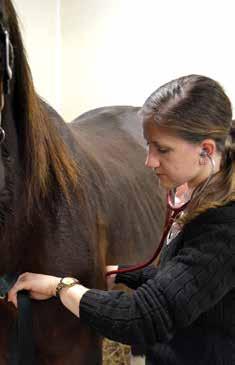
But she was “dead set against Penn” when considering vet schools, applying only because her mother insisted. “I was a country girl who didn’t want to live in Philadelphia,” she said.
On the day of her interview she toured New Bolton Center with Dr. Eric Parente. “By the end of the day I knew this is where I wanted to be,” she said. “It was a sense of belonging I had not had in any other place.”
Following her acceptance to Penn, she was awarded an Opportunity Scholarship, which provided financial aid and also paired her with mentor Dr. Patricia Sertich, V’83, Associate Professor of Reproduction at New Bolton Center.
After Moore’s first year in vet school, Sertich arranged for her to volunteer at the Brandywine Polo Club and to collaborate on a research project with Internal Medicine’s Dr. Rose Nolen-Walston.
The project researched how clenbuterol affects muscle mass in the horse. Moore administered clenbuterol to the polo ponies, and measured the fat on their rumps using ultrasound to assess their change in percent body fat. The data culminated in a publication in the American Journal of Veterinary Research and presentation of the project at a national conference.
“Dr. Sertich has set me up for success,” Moore said. “She’s been amazing.”
One of her favorite nights of vet school was at New Bolton Center on March 29, 2014, when mare My Special Girl gave birth to the colt, Boone, with the world watching on the live feed from Penn Vet’s Foal Cam.
“I can’t believe I got so lucky,” she said. “My parents were watching on the Foal Cam. We were doing our nightly checks and I told Dr. Emily Setlakwe, ‘I think she is in stage one,’ and sure enough, she was.”
Encouraged by Sertich, Moore spent summer 2014 at Rood & Riddle Equine Hospital in Kentucky for the vet-shadowing program. Following graduation this spring, Moore will work as a rotating intern at Mid-Atlantic Equine Medical Center in Ringoes, New Jersey. “It was again one of these things that felt so right. I knew I didn’t want to be anywhere else,” she said.
Moore said she envisions a career in equine internal medicine. “Most people don’t get to say they can do their dream job, and I do,” she said.
Penn Vet Class of 2016
“I can’t believe I got so lucky. My parents were watching on the Foal Cam. We were doing our nightly checks and I told Dr. Emily Setlakwe, ‘I think she is in stage one,’ and sure enough, she was.”
WWW.VET.UPENN.EDU/BELLWETHER 23
CAITLIN Moore
2019 CLASS OF
BY THE NUMBERS
120 students
45 students from Pennsylvania 20 Pennsylvania counties represented 14 students who participated in the Summer VETS program
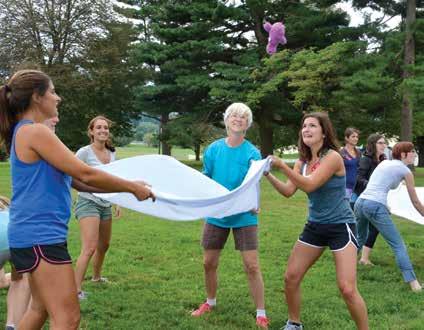

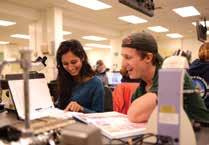
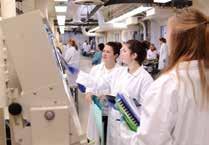

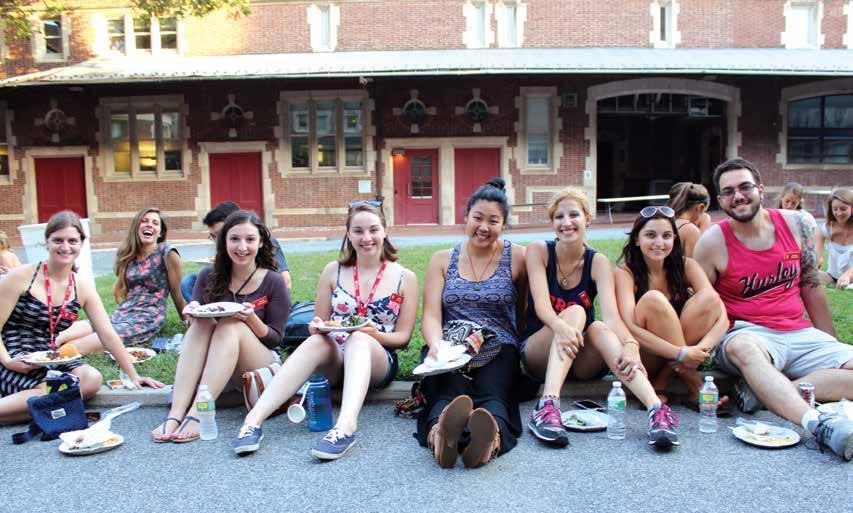
3 international students
2 Penn Vet legacy students
24 BELLWETHER SPRING 2016
SCAVMA AUCTION

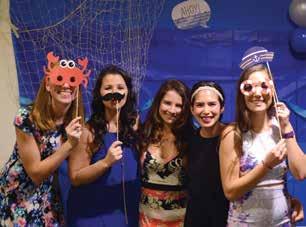
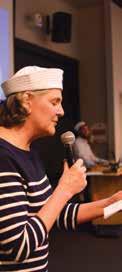

(Photos at left and bottom row) Penn Vet’s Student Chapter of the American Veterinary Medical Association (SCAVMA) held a nautical-themed auction this year to raise money for the organization. Students, faculty, staff, donors, alumni, and parents donated a variety of items for the silent and live auctions. Proceeds from the auction allow SCAVMA members to attend conferences and symposia throughout the year.

ONE HEALTH AWARDS

(Below) Penn Vet Dean Joan Hendricks is flanked by the winners of the 2015 One Health Award, Drs. Haim H. Bau and Changchun Liu of Penn’s School of Engineering and Applied Science. Bau and Liu have developed an inexpensive, high-sensitivity platform for molecular diagnostics at the point of care. They have used the new platform to adapt existing technologies to detect pathogens in humans, animals, food, and water.
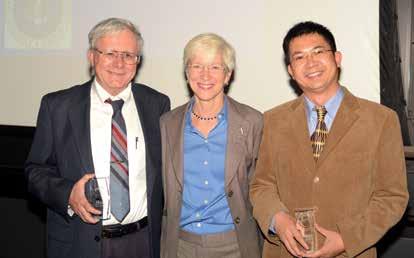
The One Health Awards are announced at the beginning of the Microbiome Symposium. Dr. Jo Handelsman, Associate Director for Science at the White House Office of Science and Technology Policy, delivered the keynote speech at the 2nd annual Microbiome Symposium.
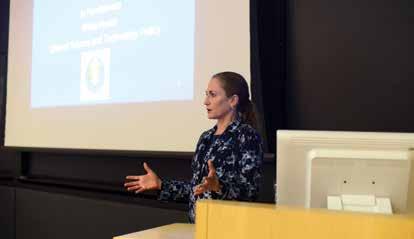
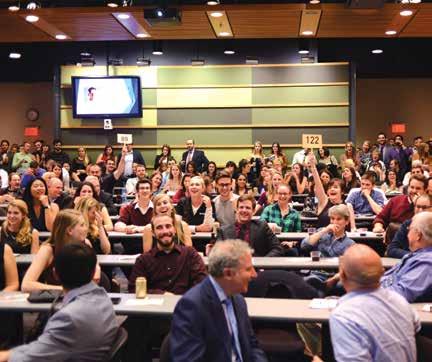
WWW.VET.UPENN.EDU/BELLWETHER 25
EVENTS
White Coat Ceremony Class of 2017
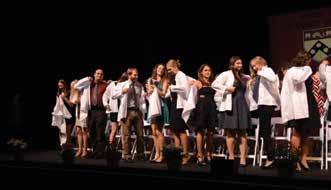

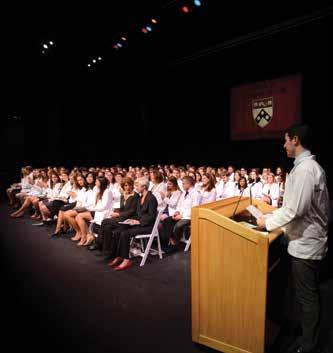
Veterinary school is as terrifically rewarding as it is arduous. Emotionally, physically, and personally. For the families, friends, and mentors joining us tonight, you are likely well acquainted with how quickly the euphoria of having successfully completed our first spay can give way to panic over an upcoming exam. For two-and-a-half years you have patiently fielded our tearful phone calls, first-year insecurities, and second-year doubts, and you have endured the holiday dinners when we excitedly dove into a rapid-fire recounting of something that promptly nauseated the rest of the table.
If we have made it to tonight in reasonably sound physical and mental condition, it is because you have been there for us. It is because no matter how long we go without calling, or how many occasions we miss due to late nights spent studying, or with what certainty we will find another poor, pathetic creature to add to our already sizeable menageries, you continue to support and to love us. You have cared for us when we were exhausted, and ill, and in those heart-wrenching moments when we questioned if this would all be worth it in the end. And I am sure that I am safe to speak for the entirety of V’17 when I say that we are tremendously grateful.
In reflecting on the past two-and-a-half years, I can’t help but be amused that perhaps the best decision I have made regarding my career in veterinary medicine has been choosing to defer my veterinary education. In doing so, I have had the good fortune to be a part of the incredible Class of 2017. Of course, when I arrived at Penn Vet for the first day of orientation, I was terrified. I was afraid that you, my classmates, would all be infinitely more intelligent, better clinically prepared for our chosen profession, and possessed of greater charisma than I could ever hope to emulate. And what a genuinely rewarding experience it has been to have had you prove me correct on every count!
How wonderful to be surrounded by peers with backgrounds in criminal justice, mathematics, French, anthropology, and dance; classmates who hail from as far away as Puerto Rico, Scotland, and Greece, and from every corner of the United States. Before arriving at Penn Vet, we were neuroscientists, dairy herdsmen, and systems engineers in defense; valedictorians, captains, and presidents. It would have been easy, even expected, that placing 126 such driven, focused, and ambitious individuals under the same academic and professional pressures would result in anything but camaraderie. And yet, that is precisely what we have achieved. We have applied our strengths, talents, and personal

26 BELLWETHER SPRING 2016 EVENTS
In November, Penn Vet’s Class of 2017 took part in the White Coat Ceremony, marking the end of their core curriculum and the beginning of clinical rotations. Among the highlights was a moving speech by Alexandra St. Pierre, V’17. Here is the speech in its entirety.
connections to better the class as a singular entity, without expectation that these acts of goodwill be returned in kind.
When asked why it was more shameful for a Spartan to be caught without his shield than without his sword, King Demaratus replied, “Because the latter they put on for their own protection, but the shield for the common good of the whole line.” Whether by sharing massive compilations of study questions, the sudden and consistent appearance of baked goods during midterms, or an outpouring of support for a classmate who has found a stray pit bull in the middle of the night, the Class of 2017 shields its collective well-being. And it is this willingness to give selflessly of ourselves, to celebrate the individual successes of our peers, and to pull together rather than apart when placed under tremendous strain, that I find truly admirable.
There is a pervading sentiment not only in the world of veterinary medicine, but in American culture generally, that to succeed you must excel. But if I have anything to offer to this talented and accomplished class, it is that excellence can be found in doing the ordinary well. In demonstrating gratitude often and openly, in being kind to those around you, and in possessing courage and humility in equal parts. And what better confirmation of the joy to be had from the many small pleasures of the everyday, than in enjoying the company of an animal who is loved? In return for the most basic offerings of food and water, a place to sleep, and a bit of our time and affection, we are gifted with an animal’s remarkable capacity to provide comfort, security, and a sense of purpose to their human comrades.
We have long employed animals to assist our disabled, to aid in the development of life-saving medical advances, and to comfort those for whom human contact is simply not enough. The tender simplicity of the human-animal bond has long been appreciated in the written tradition, with one of my favorite examples appearing in Homer’s “Odyssey.” When Odysseus finally returns to Ithaca, the only one who is able to recognize the infamous Greek strategist is his aging hound, Argos. Overjoyed at seeing his master, Argos flattens his ears and wags his tail, but is too weak to rise to greet Odysseus who cannot risk revealing his true identity by acknowledging his beloved dog. Yet despite his resolve to maintain his guise until he has reclaimed his homeland, Odysseus—who has up until this point, shed tears only for the heroes who fell at Troy—weeps at the sight of his old dog who is happy simply because after 20 years of waiting, his human has finally returned home.
Many of us, if not all of us, have had the great privilege of coming home to our own Argos. They go by different names of course, by Olly and Otto, Bain, Finn, Sunny, and Sampson. Then there’s Wellie, Willy, and Isabeli. There are bunnies, too, like JaeJae and Samuel L. Jackson, and cats like Penny and Peaches; Twist the rat, and even a cow named Rosie. So despite the sleepless nights and early mornings ahead, and regardless of how many hours we clock in at the wrong end of one species or another, and even though it will take considerable presence of mind to handle the moment when I realize Dean Richardson’s questions are coming from the man himself rather than the relative safety of a test page, I cannot imagine a more rewarding career than to have devoted ourselves to caring for the animals who so effortlessly enrich our own lives.
To my classmates, I wish you all the best as we take this next step on the path to becoming veterinarians. Have a lovely evening with your guests and may your white coats receive a proper breaking in from your loved ones waiting patiently at home. Congratulations, V’17.

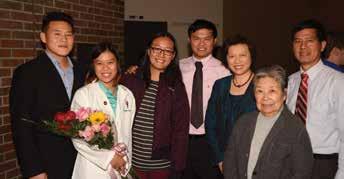
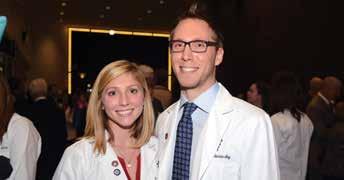
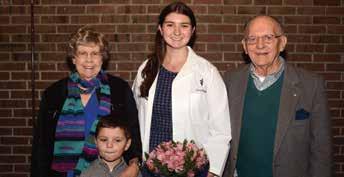


WWW.VET.UPENN.EDU/BELLWETHER 27 EVENTS
VMD-PhD Student Sylvia Qu

Using engineering to bridge the gap from bench to bedside
By Katherine Unger Baillie
Like many veterinary students, Feini (Sylvia) Qu grew up with a love for animals and zoology. In college, she volunteered at a lemur research center and traveled to Paraguay to study tropical birds. She also shadowed veterinarians as they worked in clinics seeing patients.
But unlike many traditional vet students, the tools and technology the clinicians used fascinated Qu almost as much as the practice of medicine itself.
“I was so excited by the instrumentation,” Qu says. “I always wanted to know how a probe or any given piece of equipment does what it does.”
That fascination led her to Penn Vet’s VMD-PhD Program, and to pursue interdisciplinary research into tissue engineering to create a better approach to connective tissue repair surgeries—for both people and pets.
Qu majored in biomedical engineering as an undergraduate at Duke University and entered Penn Vet’s dual-degree program with a good sense of what she wanted to pursue for her PhD. While some combined-degree students rotate through different labs during the summers between their first years of veterinary school, she spent much of her time in the lab of Dr. Robert Mauck, Associate
Professor of Orthopaedic Surgery and Bioengineering, with appointments in the Perelman School of Medicine and the School of Engineering and Applied Science.
“I came in with an interest in tissue engineering and orthopedics,” she says. “I wanted to be the person with a knowledge of both the engineering side and the veterinary side to help with making the bench-to-bedside transition.”
To do so, preclinical studies in large animal models are typically a necessary step, and were a major part of Qu’s dissertation research, which focused on strategies to repair injuries to connective tissues such as tendons, ligaments, and cartilage.
In particular, Qu zeroed in on attempts to repair the meniscus, a rubbery, C-shaped piece of dense tissue known as fibrocartilage that cushions the knee joint. Meniscus tears
28 BELLWETHER SPRING 2016
RESEARCH BRIEF
“I always wanted to know how a probe or any given piece of equipment does what it does.”
are a common injury, but very difficult to repair because only the outer third of the tissue receives significant blood flow. Injuries that are complex or that affect the inner part of the meniscus are treated by surgery to cut out and remove the torn portion, rather than attempt a repair.
For decades, researchers have attempted to encourage better healing by designing scaffolds on which new cells could accumulate, but efforts have fallen short. Qu, collaborating with Mauck and postdoctoral researcher Dr. Matthew Fisher, worked on an innovative approach to build a nanoscale scaffold that would not only direct cells where to go and how to be structured appropriately, but would also influence tissue at the repair site to increase the odds of a successful healing process.
Her work was based on the recognition that fetal connective tissue is better at healing than adult tissue. Using advanced imaging technology, Qu found that this enhanced healing capability may be due to the fact that, whereas adult connective tissues such as the meniscus are stiff and dense so as to bear up under heavy loads, fetal tissue is less dense and softer. This “looser” structure is more conducive to allowing cells to migrate through a tissue to a wound site and promote healing.
What if, the researchers wondered, they could somehow revert adult tissue to a more fetal-like state to improve healing?
“The idea is to degrade the tissue next to the wound site so it’s looser and easier for cells to migrate in,” Qu says.
Qu and colleagues first worked in vitro to examine whether the collagen-degrading enzyme collagenase effectively digested the extracellular matrix of adult cow meniscus tissue. They found that, indeed, the matrix density decreased and the number of cells increased when incubated with the enzyme.
But the researchers didn’t want to have to soak damaged meniscus tissue with an enzyme, because it could also degrade healthy tissues. A more targeted approach involved using a nanofiber-crafted scaffold embedded with the enzyme, which could be implanted into the wound site and would release the enzyme selectively into the adjacent tissue.
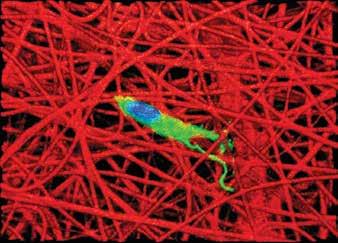
They did an initial in vivo test of the scaffold construct in a rat model to evaluate its activity and safety. They again took cow meniscal tissue, placed the scaffold inside to replicate a wound closure, and implanted the tissue in the rats subcutaneously. After four weeks, they found signs that matrix density was reduced and cells were migrating into the repair site, just as they had in the in vitro experiments.
With confidence in the approach, the researchers moved into a pilot study with a large animal model: sheep, which Qu says provide an excellent model for human knee surgeries.
“Size matters,” she says. “It’s hard to do these kinds of surgeries in an animal as small as a rat or mouse. Also, the loading patterns in sheep knees are similar to those of humans.”
Dr. Thomas Schaer, Director of Penn Vet’s Translational Orthopaedic Research & Preclinical Studies program at New Bolton Center, performed the surgeries in sheep with an injury to their menisci to introduce the construct—a challenging task because the meniscus can be difficult to visualize.
The result was encouraging: those sheep who had the enzyme-treated scaffold embedded in the repair site had evidence of a robust healing response, with no evidence that other tissues were affected by the enzyme treatment.
In future studies, Qu and her colleagues hope to expand the investigation to evaluate longer-term efficacy of the scaffold-aided repair. She is also exploring a strategy to deliver an additional drug that could work in conjunction with collagenase to promote healing.
And because the meniscus tissue resembles that of many other dense connective tissues in the body, the work could be applied broadly—even in companion animals. Dogs, for example, commonly injure their meniscus when they experience a cranial cruciate ligament tear, akin to an ACL tear in humans.
“I see this as a treatment that could help a lot of injured canine companions,” Qu says.
As a side project, Qu is working with a graduate student in Penn’s Computer and Information Science Department to design a wearable wireless electronic device that would measure how well a joint returns to function after a surgery, looking at its ability to bear weight and achieve a wide range of motion.
Qu is hopeful that her work contributes to more overlap and exchange between the engineering and veterinary fields.
“We’ve started building this bridge between these two disparate worlds that really shouldn’t be disparate,” she says.
WWW.VET.UPENN.EDU/BELLWETHER 29
RESEARCH BRIEF
A meniscus cell (meniscal fibrochondrocyte) migrates onto an electrospun polymer nanofibrous scaffold. The red represents individual polycaprolactone nanofibers.
FRIENDS SUPPORT THE FUTURE TO HONOR THEIR PAST
BY SACHA ADORNO
DR. LILLIAN A. GIULIANI AND DR. CHARLES (CHARLIE) KOENIG, BOTH V’57, KNOW THAT RIGOROUS CLASSWORK, LONG DAYS, AND INTENSE SCHEDULES ARE HALLMARKS OF PENN VET’S EXCELLENCE—AND THAT FELLOW STUDENTS, FACULTY, AND ALUMNI, WHO KNOW WHAT IT’S LIKE, CAN MAKE GETTING THROUGH ALL THE EASIER.
Friends from day one of vet school, Giuliani and Koenig remain close more than 50 years later. After graduation, both remained in the Philadelphia region. Giuliani started Pets First Veterinary Center in Bryn Mawr, Pennsylvania, where she still puts in two days a week after selling the practice in 2000. Koenig, who retired in 2015, was the founding partner of Limerick Veterinary Hospital. Through the years, they’ve been part of Penn Vet’s alumni network, supporting each other, early career veterinarians, and students.
Recently, to honor a beloved Penn Vet mentor, Dr. Charles W. Raker, V’42, Giuliani, Koenig, and Koenig’s wife Sandy came together to support Penn Vet’s unique Opportunity Scholarship Program. The late Dr. Raker—one of New Bolton Center’s founding fathers and a giant of equine veterinary medicine—started the scholarship program in 1998 to provide both financial assistance and mentoring to Penn Vet students.
Giuliani and the Koenigs each endowed scholarships—the Lillian A. Giuliani V’57 and the Sandra and Charles Koenig V’57 Endowed Opportunity Scholarships, respectively—that will enable the School to continue recruiting veterinary medicine’s most promising students.
Bellwether spoke with them about their gifts, Penn Vet, friendship and mentorship, and Raker’s tremendous legacy.
ON GETTING TO PENN VET
Giuliani: My first job after college was in Dr. Israel Live’s lab at Penn Vet. He was a brilliant man. But, after some time, I realized research wasn’t really where my heart or brain was. Back then, the lab’s window overlooked the stables, and I’d watch Dr. Raker with the Thoroughbreds. They were magnificent, and he was amazing with them. He really spurred me to apply to the School.
30 BELLWETHER SPRING 2016
Koenig: Every kid wants to be a veterinarian somewhere along the line. I studied arts and sciences in college. And my brother-in-law— Harold Ayres, V’51—was a veterinarian, and he leaned on me to be a vet...Of course, he recommended Penn Vet for study.
ON FRIENDSHIP
Giuliani: Charlie [Koenig] and I both went to the same high school, although we didn’t know each other. I am seven years older so our paths didn’t cross. We really met at Penn Vet—everyone looked up to Charlie. In our day, the School’s classes were so small. You were able to get to know classmates really well. It was a nurturing place for friendships.
Koenig: Lil’ G was the big sister of our class. She had a wonderful spirit and liked everyone. She was a really classy, strong presence. In particular, bacteriology was a very difficult course. She helped a lot of us through it—she was very generous with her time and knowledge. Students went through a lot together at Penn Vet and that made us a support group of sorts, as classmates and an alumni network.
ON DR. RAKER AND MENTORING
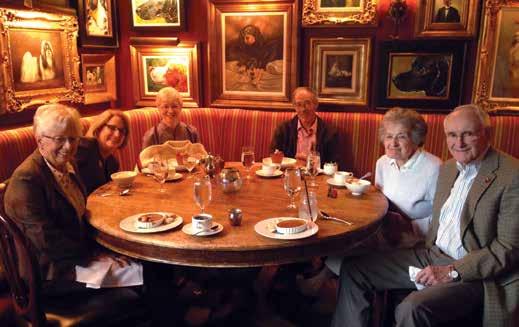
Giuliani: Charlie [Raker] was a true mentor, a very fine man. I was one of four women in a class of 43, and he really led the way for us. More than just encouraging women to apply, he treated all students the same and was available to us equally. I’ve always tried to follow his example. I believe it’s not enough
to do well in life; it’s also our responsibility to show the way to others.
Koenig: We all loved Charlie. He held everyone to pretty high standards. Although he was tough, everything he expected and demanded of us was to make us better veterinarians. He only wanted the best from and for us.
I’ve mentored students for the Opportunity Scholarship Program. It means a great deal to them that I experienced what they’re experiencing now; that they’ll find a way through whatever problem they’re having with a discipline. I tell them that we have a common bond: we were chosen to be veterinarians.
ON GIVING BACK
Giuliani: I received so much from Penn Vet that it’s only reasonable to give back. The School admitted me at a time when vet schools weren’t really accepting women. My education was excellent, and I was treated with respect. All of this was a gift that needs to be recognized. The Opportunity Scholarship Program is a way to express gratitude.
Koenig: Veterinary medicine has always been good to my family and me. This Opportunity Scholarship Program is important for current students and for Penn Vet to attract great students. I first heard about the scholarship years ago, from Charlie himself. He came up to me during an alumni weekend and said, “I have a neat program that you’re going to want to be part of.” He was right.
ABOUT THE OPPORTUNITY SCHOLARSHIP PROGRAM
The Opportunity Scholarship Program provides financial support and matches students with practicing veterinarians as mentors. Throughout school, students connect with their mentors and scholarship sponsors for encouragement. To learn more about this special giving opportunity, contact Jillian Marcussen, Director of Development, at 215-898-4235 or jillian2@vet.upenn.edu.
WWW.VET.UPENN.EDU/BELLWETHER 31
From left to right: Sandra Koenig, Assistant Dean of Advancement Carol Pooser, Penn Vet Dean Joan Hendricks, Andy Elser, V’87, Lillian Giuliani, V’57, and Charles Koenig, V’57.
FATHER’S GIFT TO VITE LAB IS PERSONAL
BY SACHA ADORNO
SOON
WITH DOCTORS UNABLE TO IDENTIFY THE CAUSE, GALYA SPENT THE BETTER PART OF HER FIRST YEAR IN AN INTENSIVE CARE UNIT.
After 12 frustrating and frightening months, the Chans finally received a diagnosis of Niemann-Pick type C disease (NPC), a rare, incurable childhood disease caused by the accumulation of excessive amounts of cholesterol and glycosphingolipids in the brain and other organs. Without FDAapproved treatments, and with only drugs to manage symptoms, young people with the degenerative condition often die before the age of 20.
“NPC is so rare that in all of Los Angeles, where we live, there are only four known cases,” says Brian Chan, Galya’s dad. “I’ve spent hundreds of hours researching it and talking to other families. As most NPC families do, I eventually ran into Dr. Vite at Penn Vet.”
Dr. Charles H. Vite, Associate Professor of Veterinary Neurology, is part of a
collaborative community of researchers around the world who are tackling NPC. Recently, he was the lead author of a study published in Science Translational Medicine that finds cats with NPC show vast improvement when treated with a compound called cyclodextrin. While NPC, which naturally occurs in cats and follows the same progression as it does in children, typically results in inexorable neurological decline, administering cyclodextrin into the fluid around the cats’ brains largely halted the disease’s progression. This study paved the way for the FDA to approve a Phase I clinical trial in children. A Phase 2/3 trial began this past fall.
For the Chans and other parents of children with NPC, breakthroughs like this offer hope. Determined to maintain forward momentum, they have become
32 BELLWETHER SPRING 2016
AFTER GALYA CHAN WAS BORN, HER LIVER BEGAN GROWING AT AN ALARMING RATE—SO QUICKLY THAT BY THE TIME SHE TURNED ONE, IT WAS THE SIZE OF A 13-YEAR-OLD’S.
active participants in NPC research, getting to know scientists and raising funds to keep studies moving.
Brian Chan is the founder of Liferay, Inc., an open source software company, and part of SOAR-NPC (Support of Accelerated Research for NPC), a scientist-clinicianpatient advocate collaborative. After visiting Dr. Vite’s lab with a group of parents, Chan asked what was needed to accelerate research. “A new microscope was high on the list,” Chan says.
Without hesitation, he offered to support the purchase of a state-of-the-art microscope that will greatly enhance Penn Vet’s ability to study NPC. Features like whole-slide scanning and 3-D reconstruction; digital archiving and sharing functions; highresolution and live-cell, real-time imaging; and multiplexing capabilities will enable a
better understanding of NPC’s process. As a result, researchers can spend more time analyzing data and less time imaging it.
“We are grateful to Brian for this gift, and thankful for all of the determined, amazing families behind NPC research,” says Vite. “They alone have helped fund 20 percent of our lab. We have essential NIH funding—we couldn’t get by without it—but what really pushes things along is the involvement of the parents.”
Regarding this unique partnership between families and researchers, Chan adds, “Doctors and scientists take an academic approach. For parents, it’s personal. If you add a personal touch to scientific rigor, the results are better than if you have just academic data or parental passion. When you combine both… bam, things happen.”


WWW.VET.UPENN.EDU/BELLWETHER 33
“We are grateful to Brian for this gift, and thankful for all of the determined, amazing families behind NPC research.”
—�Dr. Charles H. Vite
xxx
A Voice for Shelter Animals
By Jillian Marcussen
It is hard to imagine a better advocate for shelter animals than Jerry Rosenthal. He is the former President and CEO of the Monmouth County SPCA in New Jersey, and he has been a part of the Penn Vet family for many years—supporting the School through both his philanthropy and his commitment of time and leadership as a member of the Penn Vet Board of Overseers.
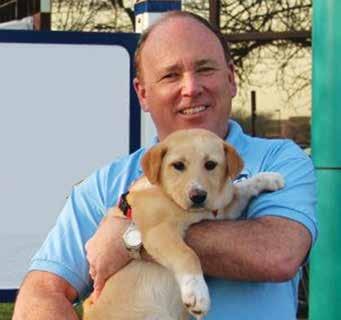
This philanthropy included a significant commitment in 2010, when he and his wife Cionna generously provided term funding for the Rosenthal Shelter Medicine Directorship. This early support provided the foundation that the Penn Vet Shelter Animal Medicine Program needed to establish the School as a resource for the region’s significant homeless pet population.
Today, thanks to the Rosenthals’ early investment and commitment to animal welfare, the Shelter Animal Medicine Program is a leader in the field. Under Director Dr. Brittany Watson, the program offers hands-on educational opportunities for students, advisory and medical services to the region’s shelters, and community outreach to local public school students and residents of West Philadelphia. To build on this momentum, and continue to enhance the program, Jerry and Cionna have once again stepped forward by establishing the Rosenthal Penn Vet Shelter Medicine Student Research Fellowship.
The fellowship will create an environment where students interested in the shelter field can have long-term mentorship throughout their veterinary school education. Students selected for the fellowship will receive funding to pursue their own research projects in areas such as decreasing stress in shelters, effective adoption strategies, ethics, and improving shelter protocols for animal health. Research projects will span three years and will offer significant benefits to the students by broadening their understanding of the challenges facing the shelter community. Their research findings will also serve as a resource to our many shelter partners.
In addition, students will participate in the Shelter Medicine Rotation in their fourth year of school and have an opportunity to publish their findings. The end result is a truly unique learning opportunity for students who share the Rosenthals’ dedication to helping homeless animals— creating future leaders in shelter medicine with the tools to effect positive change.
As Jerry Rosenthal commented, “Providing research opportunities for students to promote the field of shelter medicine was an easy decision to make. We look forward to following these future leaders’ research as they develop new advancements in this important field of veterinary medicine.”
“I continue to be inspired by Jerry and Cionna’s passion for animal welfare. They have been an integral part of the Penn Vet Shelter Animal Medicine Program for years, and this new commitment to our students is yet another example of that,” said Penn Vet Dean Joan Hendricks.
34 BELLWETHER SPRING 2016 CAMPUS UPDATES
“I continue to be inspired by Jerry and Cionna’s passion for animal welfare. They have been an integral part of the Penn Vet Shelter Animal Medicine Program for years, and this new commitment to our students is yet another example of that.”
Penn Vet Dean Joan Hendricks
Measuring Chronic Pain in Cats Help Us Meet the Challenge

As any cat owner can attest, it can be very difficult to recognize pain in felines because cats instinctively hide their symptoms. To address this issue, Dr. Dottie Brown, Director of Penn Vet’s Veterinary Clinical Investigations Center and Professor of Surgery, is leading a clinical trial that aims to create an instrument to objectively measure chronic pain in cats, an area of research that to date has been largely ignored. Such a tool would be invaluable in treating cats with conditions such as arthritis and cancer, as accurately measuring their level of discomfort is critical to effective management and treatment of these painful conditions. As part of the study, Brown will conduct ownercompleted questionnaires and employ feline activity monitors to allow for assessment in a home environment.
To raise the full $150,000 in funding needed to complete the study, we are excited to announce that the John T. and Jane A. Wiederhold Foundation will generously match donations to this trial on a dollar-for-dollar basis up to $75,000, through June 30, 2016. To make a gift, or to learn more about the trial, please contact Jillian Marcussen, Director of Development, at 215-898-4235 or jillian2@vet.upenn.edu.
WWW.VET.UPENN.EDU/BELLWETHER 35 CAMPUS UPDATES
FACULTY AND STAFF NEWS
Lillian Aronson, VMD, edited the new textbook Small Animal Surgical Emergencies, published by Wiley-Blackwell last December. Four years in the making, Small Animal Surgical Emergencies is a practical reference to soft-tissue and orthopedic emergencies commonly encountered in small animal practice.


Darryl Biery, DVM, Emeritus Professor of Radiology, received the prestigious ACVR Bernstein Lifetime Achievement Award at the 2015 ACVR Annual Scientific Meeting in Minneapolis. This award is given to members of the American College of Veterinary Radiology who have made an outstanding contribution in the form of service, teaching, or research to the College and represents the ACVR’s highest honor.
Ashley Boyle, DVM, spoke at the 2015 Northeast Association of Equine Practitioners Symposium last September in Pittsburgh, Pennsylvania. Her talks included Update on Strangles and Managing Outbreaks; Strangles – Unusual Cases and Effective Treatments; and Diagnosis and Treatment of the Sick Foal on the Farm. She published the following: Duffee LR, Stefanovski D, Boston RC, Boyle AG. Predictor Variables for Streptococcus equi subs equi Diagnosis and Complications in Horses: 108 cases (2005-2012), JAVMA. 2015 Nov 15;247(10): 1161-8
Allison Bradbury, PhD, a Postdoctoral Research Fellow in the lab of Charles Vite, DVM, PhD, was selected to receive the WORLDSymposium Young Investigator Award for 2016. The award is a partial scholarship towards attendance at WORLDSymposium 2016, and recipients are recognized at the closing banquet and award ceremony.
Dorothy Cimino Brown, DVM, gave a presentation last June entitled Spontaneous Animal Models: Unsung Heroes in Bone Cancer Pain at the 2015 American College of Veterinary Internal Medicine Forum in Indianapolis. In September, she gave three presentations entitled Targeted Neurotoxins for Chronic Pain Relief; Chronic Pain Assessment; and Designing, Mentoring, and Reporting Clinical Research Projects at the 21st International Veterinary Emergency and Critical Care Society Symposium in Washington, D.C. Also in September, Brown was part of an expert panel that discussed Bridging the Gaps between Pain Research and Osteoarthritis Research at the International Workshop on Osteoarthritis Pain at the
Nobel Forum, Karolinska Institutet in Stockholm, Sweden. Last October, she discussed Clinical research design, interpretation, and biostatistics for the practicing specialty veterinarian in the Resident’s Review Workshop at the Veterinary Cancer Society Annual Conference in Vienna, Virginia.
Stephen Cole, VMD, a Postdoctoral Fellow in Clinical and Molecular Microbiology, published two case studies (co-author: Shelley Rankin, PhD) under the AAVMC/APTR

One Health Interprofessional Education Working Group. The first was entitled Care of immunocompromised individuals: the role of companion animals in mental health. The second, Lead Poisoning: From the Backyard to the Community, was co-authored by Peter Rabinowitz, MD, MPH, of the University of Washington. In recognition of this accomplishment, Cole was named an AAVMC One Health Scholar and received two $1,000 stipends. He also presented his work MethicillinResistant Staphylococcus Species in Companion Animals from across the United States at the annual American Association of Veterinary Laboratory Diagnosticians meeting; Rankin was co-author.
Emily Daignault-Salvaggio, Medicine Secretary at New Bolton Center, and her horse Gin Joint won the Field Hunter division in the 2015 TCA Thoroughbred Makeover event last October at Kentucky Horse Park in Lexington, Kentucky. The event is presented by the Retired Racehorse Project, which aims to facilitate the placement of retired Thoroughbred racehorses in second careers.
Jamie DeFazio, VTS-EVN, CVT, lectured at the 104th annual Kentucky Veterinary Medical Association Meeting/42nd MidAmerica Veterinary Conference last September in Louisville, Kentucky. DeFazio’s topics were IV catheter placement and maintenance, disseminated intravascular dissemination, and neonatal nursing.
Raimon Duran-Struuck, DVM, PhD, presented on Treatment approaches and clinical parameters predictive of CMV disease and resolution in immunodeficient cynomolgus macaques – a clinically relevant large animal model at the American Association for Laboratory Animal Science meeting in Phoenix, Arizona, last November. He published the following manuscript: Privileged to work with animals. Duran-Struuck R. Lab Anim (NY). 2015 Oct 20;44(11):453. He also published:
36 BELLWETHER SPRING 2016 CAMPUS UPDATES
D e FAZIO COLE ARONSON
Miniature Swine as a Clinically Relevant Model of Graft-VersusHost Disease. Duran-Struuck R et al. Comp Med. 2015;65(5):42943. In addition, he published: Effect of Irradiation on Incidence of Post-Transplant Lymphoproliferative Disorder after Hematopoietic Cell Transplantation in Miniature Swine. Duran-Struuck R. et al Biol Blood Marrow Transplant. 2015 Oct;21(10):1732-8. doi: 10.1016/j.bbmt.2015.07.017. He published the following book chapter: “Biology and Diseases of Swine” by Kristi Helke, Paula Ezell, Raimon Duran-Struuck and Michael M Swindle. Biology In: Laboratory Animal Medicine. Third Edition. Academic Press. Elsevier. 2015. In addition, he published the following book chapter: “Xenotransplantation and Transgenic Technologies” by Raimon Duran-Struuck and Bram V. Lutton. In Swine in the Laboratory. Third Edition. CRC Press, 2015
Amy Durham, VMD, received the American College of Veterinary Pathologists’ Presidential Award last October at the American College of Veterinary Pathologists/American Society for Veterinary Clinical Pathology/Society of Toxicologic Pathology Combined Annual Meeting in Minneapolis.

Robert Greenberg, PhD, published the following: Song, J., Liu, C., Bais, S., Mauk, M.G., Bau, H.H., Greenberg, R.M. (2015) Molecular detection of schistosome infections with a disposable microfluidic cassette. PLoS Neglected Tropical Diseases 9, e0004318. He also published: Bais, S., Churgin, M.A., Fang-Yen, C., Greenberg, R.M. (2015) Evidence for novel pharmacological sensitivities of transient receptor potential (TRP) channels in Schistosoma mansoni. PLoS Neglected Tropical Diseases 9, e0004295.

Ronald Harty, PhD, was an invited seminar speaker last September at Indiana University School of Medicine-South Bend. His seminar was entitled Ebola Virus: Can We Nip it in the Bud? Along with Bruce Freedman, VMD, PhD, he was the co-corresponding author on the following publication: Han, Z., Madara, J.J., Herbert, A., Prugar, L.I., Ruthel, G., Lu, J., Liu, Y., Liu, W., Liu, X., Wrobel, J.E., Reitz, A.B., Dye, J.M., Harty, R.N., and Freedman, B.D. 2015. Calcium Regulation of Hemorrhagic Fever Virus Budding: Mechanistic Implications for Host-Oriented Therapeutic Intervention. PLoS Pathogens 11(10): e1005220
Mark Haskins VMD, PhD, lectured on Where we have been, where we are, and where we are going (including large animal models) at The Glycoproteinoses: Fourth International
Conference on Advances in Pathogenesis and Therapy in St. Louis, Missouri. He also delivered a lecture on Where we were, where we are, and where we are going in treating lysosomal storage diseases in the Department of Translational Medicine at The University of Naples Federico II in Naples, Italy. In addition, he received an International Society for Mannosidosis and Related Diseases Award for “a lifetime of service and knowledge of lysosomal storage diseases.”
Jessica Johnston, DVM, is a third-year laboratory animal medicine resident in the University Laboratory Animal Resources department at Penn Vet. Last November, at the American Association for Laboratory Animal Science National Meeting in Phoenix, Arizona, her poster entitled Validation of a Cage-side Glycosylated Hemoglobin Test (HbA1C) for Cynomolgus Macaques (Macaca fascicularis) won first place in the laboratory investigations category.
Meryl Littman, VMD, was a member of the Pennsylvania Department of Health’s Task Force for Lyme Disease and Related Tick-Borne Diseases. She spoke for nine hours at the New York State Spring Veterinary Conference in Rye Brook, New York, last May on Protein-losing Nephropathy (PLN), Leptospirosis, and Tickborne Diseases (Lyme Disease, Anaplasmosis, Babesiosis, Bartonellosis, Cytauxzoonosis, Ehrlichiosis, Mycoplasmosis, and Rocky Mountain Spotted Fever). She also spoke at the American College of Veterinary Internal Medicine (ACVIM) 33rd Annual Medical Forum in Indianapolis last June on the Lyme Update Panel; at the Theriogenology Conference in San Antonio, Texas, last August on Tickborne and Other Stealth Pathogen Reproductive Concerns, and Genetic Counseling for Inherited Kidney and Urinary Tract Diseases; and at the ECVIM - Companion Animals Conference in Lisbon, Portugal, last September on Genetic PLN: Genetic Testing in Combination with Blood Pressure Measurement, and Investigation of Dogs with Suspected Glomerular Disease: What is the Current State-ofthe-Art?
Carolina Lopez, PhD, published the following, which was featured by Penn News: Sun Y, Jain D, Koziol-White CJ, Genoyer E, Gilbert M, Tapia K, Panettieri RA, Hodinka RL, and López CB. (2015). Immunostimulatory Defective Viral Genomes Promote Strong Innate Antiviral Responses During Respiratory Syncytial Virus Infection in Mice and Humans. PLOS Pathog 11(9):

WWW.VET.UPENN.EDU/BELLWETHER 37 CAMPUS UPDATES
LOPEZ HARTY DURHAM
e1005122. doi:10.1371/journal.ppat.1005122. PMID: 26336095
PMCID: PMC4559413. She also published: Xu J, Mercado-López X, Grier J, Kim W, Chun L, Irvine EB, Del Toro Y, Kell A, Hur S, Gale M, Raj A, and López CB. (2015). Identification of a Natural Viral RNA Motif that Facilitates Viral Recognition by RIG-I-Like Receptors. mBio 6(5):e01265-15. doi:10.1128/mBio.01265-15
Kathryn Michel, DVM, was awarded a Master’s of Science in Education degree (MSEd) by the Penn Graduate School of Education last summer.
Lisa Murphy, VMD, was invited to join TriState Bird Rescue as the veterinarian seat on their Board of Directors, effective January 2016.
Cynthia Otto, DVM, PhD, was featured on Going Deep with David Rees on the Esquire Network.
Virginia Reef, DVM, received the American Association of Equine Practitioners 2015 Distinguished Educator – Academic Award, which honors an individual who has demonstrated a significant impact on the development and training of equine practitioners. She was recognized last December during the President’s Luncheon at the AAEP’s 61st Annual Convention in Las Vegas, Nevada. Reef completed her internship and residency in large animal medicine in 1982 at Penn Vet, where she has served on the faculty ever since.
Alexander Reiter, Dr med vet, Dipl. Tzt., gave invited presentations and laboratories in dentistry and oral surgery at the SCIVAC International Congress in Rimini, Italy, last May; the European Congress of Veterinary Dentistry in Ghent, Belgium, last June; the Veterinary Dental Continuing Education Center at Accesia in Halmstad, Sweden, also in June; the North American Veterinary Conference in Orlando, Florida, in July; the Annual Meeting of Small Animal Practitioners in Salzburg, Austria, in September; the Swedish Veterinary Dental Society in Stockholm, Sweden, in October; and the Annual Veterinary Dental Forum in Monterey, California, in November. He published the following: Jennings MW, Lewis JR, Soltero-Rivera MM, Brown DC, Reiter AM. Effect of tooth extraction on stomatitis in cats: 95 cases (2000-2013). Journal of the American Veterinary Medical Association 2015; 246: 654-660. He also published: Soltero-Rivera M, Engiles
JB, Reiter AM, Reetz J, Lewis JR, Sánchez MD. Benign and malignant proliferative fibro-osseous lesions of the oral cavity in dogs. Veterinary Pathology 2015; 52: 894-902. In addition, he published: Fink L, Reiter AM. Assessment of 68 prosthodontic crowns in 41 pet and working dogs (2000-2012). Journal of Veterinary Dentistry 2015; 32: 148-154
Dieter Schifferli, PhD, Dr med vet, published the following: Yue M, Han X, De Masi L, Zhu C, Ma X, Zhang J, Wu R, Schmieder R, Kaushik RS, Fraser GP, Zhao S, McDermott PF, Weill FX, Mainil JG, Arze C, Fricke WF, Edwards RA, Brisson D, Zhang NR, Rankin SC, Schifferli DM. 2015. Allelic variation contributes to bacterial host specificity. Nat Commun doi: 10.1038/ncomms9754

He also published: Zhu C, Yue M, Rankin S, Weill FX, Frey J, Schifferli DM. 2015. One-step identification of five prominent chicken Salmonella serovars and biotypes. J Clin Microbiol doi:10.1128/JCM.01976-15. In addition, he published: Matthews TD, Schmieder R, Silva GG, Busch J, Cassman N, Dutilh BE, Green D, Matlock B, Heffernan B, Olsen GJ, Farris Hanna L, Schifferli DM, Maloy S, Dinsdale EA, Edwards RA. 2015. Genomic Comparison of the Closely-Related Salmonella enterica Serovars Enteritidis, Dublin and Gallinarum. PLoS One 10:e0126883
Deborah Silverstein, DVM, was elected as Vice President of the American College of Veterinary Emergency and Critical Care. She is also the Scientific Program Committee Chair.

BJ Turek, VMD, a third-year resident working with the Penn Vet Diagnostic Lab Team, won the CL Davis Scholarship Award at the American College of Veterinary Pathologists/ American Society for Veterinary Clinical Pathology/Society of Toxicologic Pathology Combined Annual Meeting last October in Minneapolis.

38 BELLWETHER SPRING 2016 CAMPUS UPDATES
TUREK REITER REEF
FACULTY AND STAFF NEWS CONT’D
GRANTS
Gary Althouse, DVM, PhD, received a one-year, $10,253 grant from Merck Animal Health for the ReproPig Continuing Education Course.
Tracy Bale, PhD, received a $1,731,398 NIH/NIMH grant for Paternal Stress epigenetic programming of offspring neurodevelopment (R01). The grant spans from August 1, 2015, to May 31, 2020.

Daniel Beiting, PhD, received a two-year, $200,000 grant from the Margaret Q. Landenberger Research Foundation for The role of the microbiome in treatment and remission of inflammatory bowel disease. The grant spans from July 1, 2015, to June 30, 2017.

Ashley Boyle, DVM, received a one-year, $15,000 Annual Advancement in Equine Research Award from Boehringer Ingelheim for Validation of a point of care self-heating, microfluidic cartridge for isothermal nucleic acid amplification of Streptococcus equi subsp equi. Project collaborators include Penn Vet’s Shelley Rankin, PhD, and Haim Bau, PhD, Professor of Mechanical Engineering and Applied Mechanics in Penn’s School of Engineering and Applied Science.
Allison Bradbury, a Postdoctoral Research Fellow in the lab of Charles Vite, DVM, PhD, received a grant of $216,000 (direct) from The Legacy of Angels Foundation for Lentiviral-mediated Hematopoietic Stem Cell Gene Therapy for Canine Globoid Cell Leukodystrophy. The grant spans from 2015 to 2018. She also
OBITUARIES
received an F32 grant from NIH for $142,796, also spanning from 2015 to 2018.
Dorothy Cimino Brown, DVM, received a one-year, $318,669 grant from Regeneus Ltd. The study, which commenced last November, will assess pain and dysfunction in 80 clientowned dogs with osteoarthritis. Dogs will be treated with CryoShot Canine, a proprietary “off-the-shelf” allogeneic stem cell therapy, via intra-articular injection, or a control, and will be assessed by validated questionnaires and forceplate analysis. The results of the trial will be used to finalize the design of a pivotal U.S. Food and Drug Administration (FDA) trial.
Zhengxia Dou, PhD, received a one-year, $44,930 grant from the University Research Foundation for Household food waste composition and recovery assessment

David Galligan, VMD, MBA, and faculty in the Center for Animal Health and Productivity received a three-year, $339,750 China Research and Engagement Fund grant from the Office of the Provost. The grant is for the project Improving the productive and health efficiency of the Chinese Dairy Industry. The project will focus on developing an integrated training program for upper level dairy managers over a three-year period of time with three specific focus areas: (Year 1) Nutritional Production Efficiency; (Year 2) Reproductive Efficiency; (Year 3) Animal Health and Milk Quality. Each focus area will be addressed by a three-day
Kathleen Lundy Dunn passed away peacefully in Austin, Texas, on October 9, 2015. Kathleen was a psychiatric social worker at Penn Vet and helped countless clients get through difficult times. The grief support group she founded was recognized as the first of its kind in a university veterinary teaching hospital and provided emotional support for clients of Ryan Hospital as well as clients of other veterinarians. She also brought her beloved dogs to cheer patients at Ronald McDonald House and area cancer centers.
Joseph James McGrane, Jr., passed away peacefully on November 22, 2015, at his residence in Palmyra, New Jersey, surrounded by his family. Born in Philadelphia, Joe had just celebrated his 70th birthday. Joe was employed for 52 years as a lab technician in the Department of Pathobiology at Ryan Hospital. Memorial contributions may be made to Esophageal Cancer Awareness, P.O. Box 55071 #15530, Boston, MA 02205.
WWW.VET.UPENN.EDU/BELLWETHER 39 CAMPUS UPDATES DOU BEITING
BALE
GRANTS, CONT’D
training seminar at the Wharton China Center in Beijing, covering key production indices for upper management. Additionally, a five-day training program will be provided each year at New Bolton Center. Project collaborators include James Ferguson, VMD, and Zhengxia Dou, PhD
Karina Guziewicz, PhD, received a two-year, $959,074 grant from the Foundation Fighting Blindness for Leading the collaboration as PD/PI AAV-mediated therapy for Best Vitelliform Macular Dystrophy

David Holt, BVSc, received the $30,000 Mari Lowe Pilot Award for Near-Infrared Imaging of Spontaneous Canine Tumors Accurately Delineates Tumor Margins and Detects Lymph Node Metastases. The award spans from July 1, 2015, through May 31, 2016.
Christopher Hunter, PhD, received a $1,125,000 NIH/NIAID grant for Immunopathogenesis of Toxoplasmic encephalitis (R01). The grant spans from September 2, 2015, to February 29, 2020.
Leszek Kubin, PhD, Research Professor of Physiology in the Department of Biomedical Sciences, was awarded a fouryear research grant by the National Heart, Lung, and Blood Institute of the National Institutes of Health, for $1,000,000 total direct cost. Beginning May 1, 2015, the award will support another four years of the research program entitled Premotor Control of Upper Airway and REM Sleep Atonia that Kubin initiated in the department 23 years ago. This segment of the project will use transgenic rodent models and the technique of optogenetics to selectively stimulate the neurons in the brain that produce the neuromodulator norepinephrine. The goal is to determine whether activation of these neurons can help maintain the airway open during sleep. As such, the study will explore whether activation of norepinephrine-containing neurons can ameliorate sleepdisordered breathing in patients with the obstructive sleep apnea syndrome.
Christopher Lengner, PhD, received the $30,000 Mari Lowe Pilot Award for Identifying markers for the prospective isolation of quiescent stem cells. The award spans from July 1, 2015, through May 31, 2016.
Carolina Lopez, PhD, received a two-year NIH R21 AI109472 grant to study innate immune response to influenza virus infection. The grant is for $250,000 total direct cost.

Michael May, PhD, received a $269,501 NIH/NHLBI grant for Targeting NF-kB in Athersocierosis (R56). The grant spans from September 15, 2015, to August 31, 2016.

Cynthia Otto, DVM, PhD, received a $11,340 grant from AKC-CHF to fund the 15th year of monitoring the health and behavior of the search and rescue dogs that responded to 9/11. There are two surviving responders and one control. The grant spans from December 1, 2015, through November 30, 2016.
Alexander Reiter, Dr med vet, Dipl. Tzt., received a $9,000 grant from the Center for Human Appearance (CHA) for Craniofacial disfigurement from a One Health perspective. The grant spans from 2015-2016, and project collaborators include Maria Soltero-Rivera, DVM, and Diana Sweeney, parent liaison in the Division of Plastic Surgery at The Children’s Hospital of Philadelphia.
Deborah Silverstein, DVM, received a $5,000 grant from Frankie’s Friends for Comparison of Two Methods of Blood Sampling and Two Anesthetics on Extended Database Values The grant spans from August 1, 2015, to July 31, 2017.
Regina Turner, VMD, PhD, received a one-year, $84,000 grant from Irvine Scientific for Evaluation & Optimization of Media for In Vitro Maturationi (IVM) of Mammalian Oocytes and Culture Media for Embryos. She is collaborating with Victor Absalón-Medina, Director of New Bolton Center’s Large Animal Gamete & Embryo Manipulation Laboratory.
Charles Vite, DVM, PhD, received a two-year, $100,000 grant from the Ara Parseghian Medical Research Foundation to study Postsymptomatic cyclodextrin therapy. He also received a five-year, $791,300 grant from Biomarin for Intrathecal recombinant GALC administration to treat canine Krabbe disease. Additionally, he received a one-year, $38,013 grant from Biomarin for a 26-week or longer Intracerebroventricular (ICV) Infusion Study of BMN 250 Administered Biweekly in a Canine Model of Mucopolysaccharidosis type IIIB (MPS IIIB)
40 BELLWETHER SPRING 2016 CAMPUS UPDATES
OTTO MAY
TURNER
STUDENT NEWS
Sarah Colmer, V’17, was selected as one of five inaugural recipients of a $5,000 scholarship through the Merck Animal Health/American Association of Equine Practitioners (AAEP) Foundation scholarship program. The scholarships were presented on December 7 during the Frank J. Milne Stateof-the-Art Lecture at the AAEP’s 61st Annual Convention in Las Vegas. The Merck Animal Health/AAEP Foundation scholarship program rewards second- and third-year veterinary students dedicated to equine medicine for their academic excellence, leadership in their school and AAEP student chapter, and their long-term goals. Colmer has worked in the Laminitis Lab and also did an NIH-Merial summer research fellowship with Hannah Galantino-Homer, VMD, PhD. Additionally, Colmer is the recipient of a 2015-2016 New Jersey Veterinary Foundation Education Grant ($1,000).
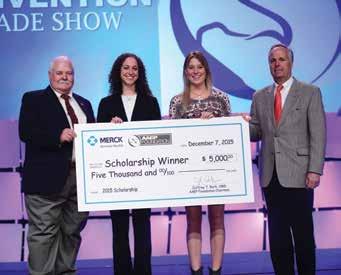
Ashley Klein, V’16, won the Society of Toxicologic Pathology Student Poster Award for The Effect of PI3K Gamma KD and PI3K Delta KD on Intestinal Lesions in Mice with DSS-Induced Colitis, along with A. Guy, J. Vegas, F. Schoetens, J. E. McDuffie, W. Fung-Leung, T. Rao, B. Zimmerman, and C. Lou.
Matthew Lanza, V’17, and Ayla Musciano, V’16, along with Amy Durham, VMD, and Richard Dubielzig, DVM, won the American College of Veterinary Pathologists (ACVP) Veterinary Student Poster Award (Clinical Case Report/Series) for Clinical and Pathological Classification of Canine Intraocular Lymphoma at the 2015 ACVP/ASVCP/STP Combined Annual Meeting last October in Minneapolis.
Meghana Pendurthi, V’17, was elected to the position of SAVMA Secretary-elect at the American Veterinary Medical Association (AVMA) Convention 2015 in Boston. She has represented Penn Vet for the past two years at national Student AVMA (SAVMA) meetings, and she will spend the next two years on the Executive Board, representing the student body as a whole. She will be following in the footsteps of Ilana Yablonovich, V’16, who is the current SAVMA Secretary.
WWW.VET.UPENN.EDU/BELLWETHER 41 CAMPUS UPDATES
SARAH COLMER, V’17 (second from left)
New Hires to Provide Valuable Resources for Penn Vet Students
By Ashley Berke
When Dr. Mary Bryant, V’95 (pictured above, at center), began her role as Executive Director of the Office of Students last May, she embarked on a team-building exercise with her staff. One of the ideas that emerged from this activity was to rename the office as “the Office for Students.”

“Our office is here to serve the students,” said Bryant. “One of our primary goals is to oversee their welfare and needs during their years on campus. It seemed fitting to adjust our name accordingly.”
And the change has gone far beyond a simple name alteration. Under Bryant’s leadership, the Office for Students has hired three new employees to serve as student advocates.
Dr. Dana Lehman
As part of the University’s ongoing efforts to address mental health and wellness, Dr. Dana Lehman of Counseling and Psychological Services (CAPS) is now providing counseling services to students at Penn Vet.
Lehman is stationed on-site at the School several hours each week in the evening to accommodate student clinical schedules. If this special pilot program is successful, CAPS hopes to expand such services to other graduate schools in the future.
“Student mental health is an area of growing concern, and I’m thrilled that Penn Vet is taking the issue so seriously,” said Lehman. “Being at Penn Vet allows students immediate access to services they might not be able to utilize otherwise. I’m excited to be part of the Penn Vet community, and of this innovative program.”
Lehman is a graduate of the clinical psychology program at Widener University. She is the former director of the Eating Disorder Day Treatment Program at the Belmont Center for Comprehensive Treatment and maintains a private practice in Center City Philadelphia.

42 BELLWETHER SPRING 2016
CAMPUS UPDATES
Nichole Moore, Associate Director of Financial Aid
As Associate Director of Financial Aid, Nichole Moore advises prospective and current students and their families on ways to make a Penn Vet education financially manageable, while also overseeing billing accounts and financial assistance programs.
Moore has worked at the University of Pennsylvania for 26 years in Student Financial Services, helping students and their families with billing, financial aid, and loans. She also was responsible for reviewing financial aid applications for need-based university and federal aid funding.
“I am thrilled to bring my knowledge of Penn’s financial aid programs to Penn Vet,” Moore said. “My goal is to ensure that a Penn Vet education is not out of reach for those who are interested.”
When she’s not working at Penn Vet, Moore graciously shares her expertise with others. She volunteers at a West Philadelphia community development center, where she hosts FAFSA completion nights and gives presentations about the financial aid process.
Mike O’Brien, Academic Manager
Mike O’Brien joins Penn Vet as Academic Manager, responsible for key aspects of the School’s curriculum including enrollment and grading. In addition, he schedules all classes and laboratories and maintains student transcripts and class rankings.
Before joining Penn Vet, O’Brien served as Program Assistant in the Office of Winter & Summer Sessions at Rowan University. There, he worked closely with the Office’s executive director to plan and implement student events and programs leading up to and taking place over the summer term.

Beyond working in higher education, O’Brien also has held positions in IT support and still has a penchant for technology. In addition, he is quite skilled at generating school spirit, having served as Scarlet Raptor—the mascot of Rutgers University in Camden.
“Throughout my career—whether as a Peer Mentor, IT Consultant, or Program Assistant—I have always enjoyed supporting students,” O’Brien said. “I look forward to getting to know the students of Penn Vet and working to make their years here as seamless and enjoyable as possible.”
Penn Vet Welcomes New Overseer
Penn Vet announces the appointment of Caroline Fribourg Rosen to its Board of Overseers. Overseer boards serve as bridges between Penn’s schools and centers and the community beyond campus boundaries. The President, Provost, and Board of Trustees rely heavily on these boards to help inform the work of the schools and centers.
“I am delighted to welcome Caroline to Penn Vet’s Board of Overseers,” said Penn Vet Dean Joan Hendricks. “Caroline’s background and insight into students’ educational needs will be a welcome addition to the Board’s diverse expertise.”

Caroline Fribourg Rosen
Caroline Fribourg Rosen is founder of Your Child in Focus, an educational consulting company that counsels parents on selecting the right schools for their children in New York City. Rosen worked at a number of New York City independent schools, counseling students and advising administrators and faculty on children’s learning styles and needs. She was school counselor, head of pupil services, and assistant head of the middle school at The NightingaleBamford School, where she later served on the Board of Trustees. She graduated with a degree in psychology and French literature from Wellesley College in 1982 and received her MA and MEd in psychological counseling from Teachers College, Columbia University, in 1989. Rosen also conducted post-graduate work at the Ackerman Institute for the Family and was a facilitator for Parents in Action. She and her husband have raised two children in New York City.
Rosen’s daughter started at Penn Vet in August, and her family has longstanding ties to the University of Pennsylvania. Her husband received his MBA from the Wharton School. In addition, her father was one of the founding members of the Board of Governors of the Joseph H. Lauder Institute for Management & International Studies, and her brother was Chairman of the Board of the Lauder Institute.

WWW.VET.UPENN.EDU/BELLWETHER 43 CAMPUS UPDATES
ZOOBIQUIT Y
Connec ng Health and Medicine in Animals and Humans
Saturday, April 2, 2016
Arthur H. Rubenstein Auditorium, Smilow Center for Transla onal Medicine, Perelman School of Medicine, University of Pennsylvania, Philadelphia, Pennsylvania
Join Us
How does a French bulldog with atopic dermatitis impact human medicine? What can we learn from a feather-plucking parrot? Can a gorilla with heart disease teach us anything about human cardiology? Join us Saturday, April 2 to find out!
Experts in veterinary and human medicine are often confronted with similar clinical challenges and shared diagnoses. Zoobiquity Conference 6 is designed to foster conversations and collaborations that can lead to new ways to diagnose, model, and treat diseases in all species.
Morning Case Presentations
Atopic Dermatitis and the Cutaneous Microbiome



• Atopic dermatitis with secondary staphylococcal folliculitis in a three-year-old female spayed French bulldog
• Atopic dermatitis with secondary cutaneous staphylococcal overgrowth in a three-year-old girl
Sleep Apnea Causes and Pharmacotherapies
• Restless sleep and daytime hypersomnolence in a two-year-old male English bulldog
• Hypersomnolence, loud snoring, and obesity in a 40-year-old man


Osteosarcoma Immunotherapy


• Induction and effect of anti-tumor immunity in a nine-year-old, male castrated Labrador with osteosarcoma
• Left distal femoral osteosarcoma with eventual metastatic disease to the lung in an eight-year-old boy
Afternoon Rounds
Select rounds at Penn Vet’s Hill Pavilion, Penn Vet’s New Bolton Center, and the Philadelphia Zoo will further explore the connections between animal and human health.
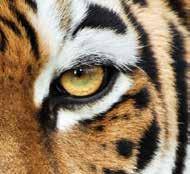
Registration


For more information and to register, visit www.zoobiquity2016.com. Registration is limited to the first 240 healthcare professionals and 70 students.
SPONSORED BY

























6 C ONFERENCE
Philadelphia
FY15 SCHOLARSHIP IMPACT
$3,947,726
TOTAL INVESTMENT IN STUDENT SCHOLARSHIP, AWARDS, AND AID
173 Pennsylvania resident scholarships awarded, totaling $1,730,000
53 recruitment scholarships awarded, totaling $790,000
51 Opportunity Scholarships awarded, totaling $153,000
39 merit scholarships awarded, totaling $410,500
5 Student Inspiration Awards funded, totaling $87,500
2 Commonwealth One Health Scholarships awarded, totaling $100,000 $686,726 in other aid
PERKINS LOAN PROGRAM UPDATE
The Perkins Loan Program, an initiative that helped half a million college students fund their education, expired last September after the Senate blocked legislation to extend it. The Perkins Loan Program was incredibly helpful for students, like those at Penn Vet, who rely on such loans to compete with tuition rates.
$1.4 MILLION raised for scholarship OVER 50% of Penn Vet students received scholarships and/or grants
$1,408,000 annual cost of the VMD-PhD Program
To support student scholarship, please visit www.vet.upenn.edu/giving/how-to-give
According to Nichole Moore, Penn Vet’s Associate Director of Financial Aid, “The absence of the Perkins Loan opportunity means that up to $32,000 will no longer be available for our students. This is a significant amount of financial aid that our students need and that we will have to replace through other funding sources.”
WWW.VET.UPENN.EDU/BELLWETHER 45 CAMPUS UPDATES
Henry and Mary Nebzydoski

46 BELLWETHER SPRING 2016
Henry Nebzydoski, V’72 Jean Nebzydoski Joseph Nebzydoski, V’82 Kerry Jo Nebzydoski
Andrew Nebzydoski, V’84 Patricia Morgan, V’85 Mary Kelly Patrick Kelly
David Nebzydoski, V’99 Beth Spinelli, V’02 Tom Nebzydoski, V’10
Sarah Vassallo, V’15 Adam Nebzydoski, V’18
Grace Nebzydoski, V’17
Chris Kelly, DVM Patrick Kelly, V’10
Henry Nebzydoski (at far right) and Mary Nebzydoski (at center) with eight of their ten children.
A Penn Vet Family Tree Grows Strong
BY KRISTEN MCMULLEN
IT IS NOT SURPRISING WHEN THE CHILD OF
A VETERINARIAN FOLLOWS IN THE PARENT’S FOOTSTEPS OR ATTENDS THE SAME UNIVERSITY. HOWEVER, THE NEBZYDOSKI FAMILY HAS TAKEN THIS TO A WHOLE NEW LEVEL.
Eleven, yes, eleven Nebzydoski family members have attended or are currently attending Penn Vet. Make that an even dozen VMDs come June 4, 2016, when VMD candidate Amanda Kiselak will marry into the Nebzydoski family.
The story began three generations ago with Mary and Henry Nebzydoski. Henry, a veteran of World War II, and Mary, a registered nurse, married and bought a dairy farm in 1948. She worked at Read Memorial Hospital in Hancock, New York, and at the farm with Henry for over 40 years.
Mary and Henry had six sons and four daughters. Three sons are VMDs who own their own practices: Henry, V’72, Joseph, V’82, and Andrew, V’84. Their other sons are Francis, John, and Thomas; their four daughters are Mary Kelly, Kathleen Painter, Margaret Tomazic, and Bernadette Franceski.
The first VMD from the Nebzydoski family was Henry, V’72. He attended the University of Scranton before veterinary school and went on to open a mixed animal practice in Pleasant Mount, Pennsylvania, later operating the Carbondale Veterinary Hospital. Henry was eventually joined in practice by three of his children: Beth Spinelli, V’02, David, V’99, and Thomas, V’10. All matriculated at the University of Scranton before attending veterinary school. After graduating from Penn Vet, Thomas pursued additional training as a farm animal medicine and surgery intern at Ohio State University in Columbus.
The second branch of the family tree starts with Joseph, V’82, who obtained his undergraduate degree and his master’s degree from the University of Scranton, where he serves on the Medical Alumni Council Executive Board. After his graduation from Penn Vet, Joseph worked as a mixed animal veterinarian and, in 1986, opened Youngsville Veterinary Clinic in Youngsville, New York.
Joseph’s daughter Sarah Vassallo, V’15, followed in her dad’s footsteps when she attended the University of Scranton and went on to study large animal medicine at Penn Vet. At New Bolton Center, she was part of the team that helped mare My Special Girl during her pregnancy with Boone, a colt delivered via a live “Foal Cam” for the world to see. Sarah and her husband are now the proud parents of a son.
WWW.VET.UPENN.EDU/BELLWETHER 47
Many VMDs were present at the 29th annual Nebzydoski family reunion in Pleasant Mount, Pennsylvania. Back row (left to right): Joseph Mastroianni, Thomas Nebzydoski, Dr. Emily Nebzydoski, Michael Heary, Thomas Nebzydoski, V’10, Ashley Dix, Father Timothy Cadigan S.J., Daniel Nebzydoski, Christopher Nebzydoski, Melissa Chiarelli, Mark Nebzydoski, Henry Nebzydoski, V’72, Andrew Nebzydoski, V’84, John Nebzydoski, and Dr. John Nebzydoski. Front row (left to right): Grace Nebzydoski, V’17, Sarah Vassallo, V’15, Joseph Nebzydoski, V’82, Bobbi Kelly, Patrick Kelly, V’10, Dr. Kathryn Pisarcik, Audrey Nebzydoski, Brian Spinelli, and Beth Spinelli, V’02
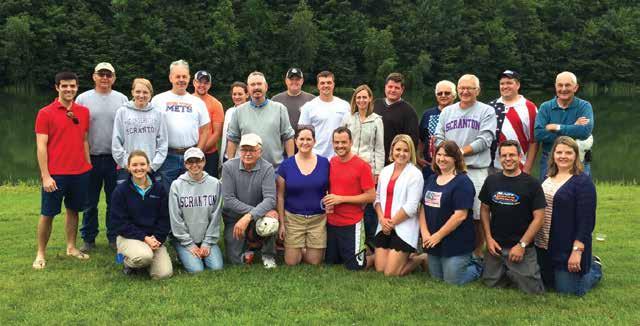
Brother Adam Nebzydoski followed in the family tradition, but took an unconventional route into veterinary medicine. Adam graduated from Penn State in 2010 with a degree in chemical engineering. He then attended the U.S. Army’s Aviation Basic Officer Leadership Course and the Initial Entry Rotary Wing course, where he was the distinguished Honor Graduate of his class. He then became an Aviation Liaison Officer for the Pennsylvania Army National Guard, serving as a Black Hawk pilot and assisting the Battalion operations officer with mission planning, mission execution, and tactical operations center duties.
Adam continues to serve as a UH-60 Black Hawk pilot and flies a minimum of eight hours per month to meet his flight requirements. After working as a project engineer with ABEC, Inc. and in production resource with Nestlé Waters North America, Adam caught the veterinary bug and headed off to Penn Vet in the fall of 2014. He will join the ranks of Nebzydoski VMDs in 2018.
Amanda Kiselak graduated from Clemson University in 2012 with a degree in animal sciences and will graduate from Penn Vet this year—just a month prior to her wedding to Adam. “My mom always said you have to have the three letters behind your name before the three letters in front of your name,” she quipped, hence why they are getting married after she graduates.
Of course, how they met involves a veterinary story. Amanda was interning with Joe Nebzydoski and riding along on large animal calls while she was applying to veterinary school. Joe gave Adam her cell phone number without her knowledge. She and Adam went on a movie date just to make his dad happy, but with a wedding date scheduled for this coming June, dad obviously knew best.
The third branch of the family tree begins with two VMDs, Andrew Nebzydoski, V’84, and his wife Patricia Morgan, V’85. Andrew is co-owner of a mixed animal practice, Wallenpaupack Veterinary Clinic in Hawley, Pennsylvania. Patricia is his

48 BELLWETHER SPRING 2016
partner in running the clinic, so Andrew knows his practice is in good hands when opportunities arise to use his veterinary skills for those in need.
Andrew has joined up with fellow alum Ted Robinson, V’74, coordinator of the Native American Veterinary Services (NAVS), which provides free veterinary care for Native Americans living on reservations throughout the United States. Andrew’s first trip with NAVS was in 2014, and he has utilized his skills by giving vaccinations, deworming, and doing spays and neuters. Between 30 and 40 people go on each NAVS trip, helping dogs, cats, sheep, horses, goats, cattle, pigs, and other animals. The participants also spread the word about veterinary medicine by speaking with students about the veterinary field and proper animal care.
Patricia and Andrew’s daughter, Grace Nebzydoski, V’17, has carried on the VMD legacy. She attended the University of Scranton, where she earned All-Academic Honors on the Equestrian Team and was inducted into Alpha Sigma Nu, the national honor society for students in Jesuit colleges and universities.
The fourth branch of the family tree includes Mary (Nebzydoski) Kelly and Patrick Kelly, whose son Patrick Kelly, V’10, is a Penn Vet graduate. The younger Patrick grew up in Baltimore and attended the University of Scranton for his undergraduate work. He joined Harleysville Veterinary Hospital in August 2010 and currently lives in Lansdale, Pennsylvania, with his wife, two daughters, and two dogs. Patrick’s brother, Chris Kelly, is also a veterinarian, having graduated from the Virginia-Maryland College of Veterinary Medicine.


Members of the Nebzydoski family have mentored numerous veterinary students, supported Penn Vet students through the Opportunity Scholarship Program, and served on the Veterinary Medical Alumni Executive Board. A legacy, a tradition, a heritage, whatever you call it, the Nebzydoski family has made their mark on the veterinary profession. We don’t think they are done just yet.


WWW.VET.UPENN.EDU/BELLWETHER 49
(Photo at left) Andrew Nebzydoski, V’84, and Patricia Morgan, V’85, with their daughter Grace Nebzydoski, V’17, on the day of her White Coat Ceremony. (Photo at right) The Nebzydoski family strongly supports the Penn Vet Opportunity Scholarship Program. Pictured at the annual Opportunity Scholarship Dinner are Joseph Nebzydoski, V’82, Hannah Izer, V’16, Andrew Nebzydoski, V’84, Scott Pandya, V’16, and Patricia Morgan, V’85
Alumni Updates
Checking in with Penn Vet graduates around the world
By Kristen McMullen
JESSICA DIMUZIO, CW’74, V’78
A high-energy veterinarian, Dr. Jessica Dimuzio wears many hats: wildlife veterinarian, conservation educator, writer, children’s book author, speaker, and owner of Nature Tales and Trails, LLC.

As a veterinarian, Dimuzio specialized in wildlife preservation. Soon after her studies of wild baboons in Kenya, Africa ended, the baboons’ home range was sold to a cooperative of small farmers who regarded baboons as pests. The only way to save the baboons was to relocate them to a remote area of the country. The realization that land preservation was as vital as species studies led her, with her husband Dr. Tim Halverson, to design holistic conservation education programs—incorporating animal studies, land use, culture, and economics. They conducted these conservation programs for college students and wildlife biologists in the United States, Africa, and Asia.
The enthusiasm of students in naturalist programs she led in the U.S. and abroad encouraged her to engage even more young people through writing as well as speaking and storytelling engagements. In her tenth year as founder and leader of the Milestones Children’s Critique Circle, Dimuzio recognizes that she has come full circle in her quest to preserve wildlife. The books she read as a child about animals and nature inspired her to respect and protect wildlife. Now, “Dr. D” writes to inspire the next generation.
Her book Bark! Bark! Bark for My Park! is told from the viewpoint of her five-pound Papillon dog, Johnny Angel. The book recounts a true struggle to save a 690-acre farm park from destruction, demonstrating that no matter what size, age, or even species you are, you have the power to make a difference. The book won the Society of Children’s Book Writers & Illustrators International Kimberly Colen Memorial Grant Award, received a Mom’s Choice Award, and was endorsed by actress and animal activist Betty White.
Her second book, Bow Wow Wow! Green Beans Now?, also a Mom’s Choice Award recipient, follows the quest
of canine conservation hero Johnny Angel for his favorite treat—garden-fresh green beans. The little dog humorously introduces children to organic gardening and the joy of eating vegetables. Mike McGrath, host of the NPR show You Bet Your Garden, has endorsed it.
As a published children’s book author, invited speaker, storyteller, and nature guide, she offers “Stories from the Wild: Programs for Your Child” through her company, Nature Tales and Trails, LLC. Her latest project, African Animals’ Lullaby (expected fall of 2016), is an immersive approach to sharing her experiences living in the bush in Kenya. Learn more at www.naturetalesandtrails.com.
COME MEET DR. JESSICA DIMUZIO AT HER BOOKSIGNING TABLE DURING THE SPRING ALUMNI PICNIC ON MAY 14 AT
ROBERT MOFFATT, V’87

Cape May Point, New Jersey, is a beautiful seaside community at the tip of the Cape May Peninsula and home to the Cape May Lighthouse. On January 6, 2015, Dr. Robert Moffatt was selected by the Cape May Point Borough Commission to serve as Cape May Point’s Mayor. He will be responsible for leading municipal meetings and general oversight of community affairs.
Moffatt, a native Philadelphian, was raised in the Germantown section of the city. In 1974, he received a Bachelor of Arts degree from La Salle University. After graduation, he relocated to Boston, where he worked in the hospitality industry. Upon his return to Philadelphia, he attended Temple University in order to meet the prerequisite science courses necessary for veterinary school. He graduated from Penn Vet in 1987.
ALUMNI NEWS
NEW BOLTON CENTER!
50 BELLWETHER SPRING 2016
Moffatt entered small animal practice in Center City Philadelphia and subsequently worked as an associate veterinarian for many years in Blue Bell, Pennsylvania. In 1993, he was one of the founders of Philly Paws (Philadelphia Pets are Wonderful Support), an organization that provided medical and general care for the pets of people who were critically ill with HIV/AIDS. In 1997, Moffatt was named one of the area’s Great Vets by Philadelphia magazine. After many years of commuting weekly to Cape May, he made the move to full-time resident in 2000 to become a Cape May veterinarian.
ADAM DENISH, V’93, AND MARNE PLATT, V’93

Dr. Adam Denish is pictured here with classmate Dr. Marne Platt, standing in front of a French veterinary hospital last July. Denish and his family were traveling through Europe and spent three days with Platt in Switzerland. Over fondue and wine, the classmates discussed
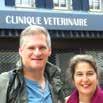
the current state of veterinary medicine, politics, and world affairs.
Platt has been a resident of Basel, Switzerland, for over five years. Denish is the owner of Rhawnhurst Animal Hospital and Elkins Park Veterinary Hospital/Boarding Kennel. He is the staff veterinarian at the Elmwood Park Zoo in Norristown, Pennsylvania, and has a special interest in exotic animal medicine and surgery.
GIVE US THE SCOOP
Doing interesting things in your career? Have any photographs with fellow Penn Vet alumni? Please send your news and photos to kmcmul@vet.upenn.edu.

alumniweekend PENN VETERINARY MEDICINE MAY2016 Save the Date for Your Class Reunion May 13-15, 2016 Reunions for classes ending in a “6” or a “1” Mark your calendar to celebrate with your Penn Vet classmates! Activities include class dinners, tours of New Bolton Center and Ryan Hospital, a Dean’s Reception, a Spring Alumni Picnic on the New Bolton Center grounds, and much more! Watch the Alumni tab at www.vet.upenn.edu for more information. www.vet.upenn.edu
ALUMNI NEWS
1960s
Wilbur B. Amand, V’66, was presented with the Frederic L. Frye Lifetime Achievement Award on October 22 by the Association of Reptilian and Amphibian Veterinarians (ARAV) for his many significant contributions to the field of herpetological medicine and surgery. The award was presented on the occasion of Dr. Amand’s retirement as ARAV Executive Director (1994-2014). Dr. Amand previously served as the Executive Director of the American Association of Zoo Veterinarians (1988-2005). He is currently the Executive Director of the American Academy of Veterinary Nutrition.
Mark Haskins, V’69, PhD’79, Professor of Pathology and Medical Genetics at Penn Vet, received an award from the International Society for Mannosidosis and Related Diseases at the Glycoproteinoses: Fourth International Conference.
1980s
Linda Mansfield, V’86, was awarded the title University Distinguished Professor at Michigan State University last November in recognition of her achievements in the classroom, laboratory, and community. Those selected for the title have been recognized nationally and internationally for the importance of their teaching, research, and outreach. Mansfield is a Professor in the departments of Large Animal Clinical Sciences and Microbiology and Molecular Genetics, and she leads the MSU Enterics Research Investigational Network.
1990s
When Nicole Ehrhart, V’90, assumed the Wilkins University Chair, she received an actual chair, engraved with her name and the name of the endowment that funds her cancer research. Known officially as the Ross M. Wilkins, MD, Limb Preservation University Chair in Musculoskeletal Biology and Oncology, the maple chair, trimmed in black and gold, is important for what it represents: a $3 million endowment ensuring that the research continues in perpetuity, and the fact that Dr. Ehrhart is the first woman at Colorado State University appointed to an endowed University Chair. At Colorado State’s Flint Animal Cancer Center, she teaches and treats animal patients. She also studies ways to prevent limb loss and to regenerate bones and muscle in people and animals whose extremities are threatened by cancer, infection, or trauma. Dr. Ehrhart employs surgical and bone-grafting techniques, as well as biologics and stem-cell therapies.
Patrick Mahaney, V’99, is the first recipient of the Dr. Greg Ogilvie CLEAR Vision Award from Canine Lymphoma Education Awareness and Research (CLEAR). The nonprofit organization learned of Dr. Mahaney’s efforts to spread education and awareness as his own dog, Cardiff, was battling the devastating disease. Mahaney is a premier, concierge, house-call veterinarian through his company California Pet Acupuncture and Wellness (CPAW), Inc. in Los Angeles. He
also provides holistic treatment for cancer patients at the Veterinary Cancer Group. Mahaney shares the story of Cardiff’s cancer diagnosis and treatment every 14 days for petMD’s The Daily Vet at www.petmd.com/blogs/thedailyvet/pmahaney.
2000s
Chuck Arensberg, V’03, got married to the beautiful Joanna Howard Jones (now Joanna HJ Arensberg) on a sunny Halloween afternoon, with fall colors in full splendor, at Grace Winery at Sweetwater Farm in Glen Mills, Pennsylvania. Penn Vet graduates Drs. Steve Berkowitz, V’83, Mark Donaldson, V’93, and Barbara Forney, V’82, were in attendance. A bluegrass band banged out tunes, Southern BBQ livened the party, and bourbon flowed smoothly. The couple is living in the “horse country” of Chester County, Pennsylvania, where Dr. Arensberg continues to work as an equine sports medicine veterinarian. Joanna, originally from Williamsburg, Virginia, and a George Mason and William & Mary graduate, is a CPA and currently a head corporate controller in the health services field. A horse farm search is now underway!
2010s
Maral Avetian, V’12, and Michael Sheruda, V’12, were married on June 6, 2015. Thomas Nebzydoski, V’10, Ashley Yanchik, V’11, and Jessica Sheruda, V’16, were in the wedding party. Also in attendance were Nicole Sinclair Torre, V’11, Chris Torre, V’12, Jon Van Blarcom, V’12, Jose Guevara, V’12, and Lauren Klutchka, V’12
Residents & Interns
The Veterinary Dental Forum, the world’s largest conference in veterinary dentistry and oral surgery, took place October 28 to November 1, 2015, in Monterey, California. Lisa Fink, DVM, who completed her residency at Penn Vet in July 2015, received the prestigious Debra B. Smith Journal of Veterinary Dentistry Editor’s Award for the best contribution by a resident to the Journal of Veterinary Dentistry in 2015. Curtis Stiles, DVM, who completed his residency in July 2006, received the American Veterinary Dental College (AVDC) President’s Medal of Honor for outstanding contributions by an AVDC Diplomate to continuing education in veterinary dentistry and oral surgery. Drs. Lisa Fink, Nicodin “Nic” Farcas, Kristen Scott, and Jerzy Gawor all received their American Veterinary Dental College (AVDC) Diplomate certificates during the award ceremony. Twenty-two of the presentations given at the Forum were presented by current or past members of Penn Vet’s Dentistry and Oral Surgery Service. In addition, past members Michael Jennings, VMD, and Kristen Walker, DVM, helped as instructors of a wet laboratory as part of the continuing education program.
ALUMNI NEWS 52 BELLWETHER SPRING 2016
The International Congress of Animal Reproduction (ICAR) has announced that Professor Katrin Hinrichs, DVM, PhD, of Texas A&M University, is the recipient of the 2016 Simmet Prize for Assisted Reproduction. Dr. Hinrichs is a graduate of the University of California at Davis. She completed a residency and her PhD at New Bolton Center, where she began her longstanding research into mare reproductive technology, including embryo transfer. The prize is the most prestigious award in animal reproduction and one of the largest of its kind. The clinical program in equine-assisted reproduction she founded in 2009, in collaboration with the Section of Theriogenology at Texas A&M, is now one of the largest in the world and performed over 450 embryo production procedures in 2015 alone.
The featured manuscript of the Journal of the American Association for Laboratory Animal Science‘s cover photo, “Evaluation of Presurgical Skin Preparation Agents in African Clawed Frogs (Xenopus laevis),” is from Blythe Philips, VMD, who completed her residency last July and is now a Clinical Veterinarian with University Laboratory Animal Resources (ULAR). The last featured manuscript, “Intraperitoneal Injection of Ethanol for the Euthanasia of Laboratory Mice (Mus musculus) and Rats (Rattus norwegicus),” was from Krystal Allen-Worthington, DVM, PhD, who completed her residency in July 2014.
In Remembrance
Stanford D. Merrill, V’39, died on December 5, 2015, at Park Residence in Waterville, Maine. Dr. Merrill conducted a general veterinary practice with his father in South Paris, Maine, for seven years. In 1946, he moved to Augusta, where he conducted a large animal practice. He then took a position with the Maine Department of Agriculture, where he organized the state poultry and meat inspection programs, retiring in 1976. These programs were later adopted by the federal matching programs. Dr. Merrill was a member of the Maine Veterinary Medical Association, serving as its president in 1948 and 1949, and as secretary-editor for six years. He also belonged to the American Veterinary Medical Association, Maine State Employees Association, and Maine Retirees Association.
Gwendolyn B. Wylde, V’40, passed away on June 6, 2015, at the age of 98. She was married to the late William H. Wylde for 68 years and was beloved by three children, six grandchildren, and six great grandchildren. Gwenn resided in Audubon, New Jersey, for more than 65 years.
George C. Poppensiek, C’40, V’42, died at age 97 in Ithaca, New York, on September 8, 2015. Dr. Poppensiek had a long and very distinguished career, beginning with an internship in large animal medicine at Penn Vet, and ending as the Dean Emeritus and the James Law Professor of Comparative
EXOTICS, ZOO, OR WILDLIFE MEDICINE?
Are you a VMD working in the field of exotic, zoo, or wildlife medicine? We would like to hear from you as we work on a feature story about our alumni working in these fields. Please email us at kmcmul@vet.upenn.edu with your name and a bio. Photos of you at work are also welcomed.
Medicine Emeritus at the Cornell University College of Veterinary Medicine. During his career, Dr. Poppensiek also held positions at the University of Maryland as an Associate Professor, and at the USDA’s Plum Island Animal Disease Center as the Supervisory Veterinarian for Diagnostic Investigations. Among his numerous awards and honors, Dr. Poppensiek received the XIIth International Veterinary Congress Prize for distinguished service to veterinary science from the American Veterinary Medical Association in 1977. Four years later, he became the first veterinarian from North America to be inducted into both the Polish Society for Veterinary Medicine and the National Argentine Academy of Agronomy and Veterinary Medicine. Dr. Poppensiek held centennial medals from both the University of Pennsylvania and the Ohio State University, each awarded independently for contributions to veterinary medical education and research. Dr. Poppensiek’s legacy is also felt in the numerous societies and organizations with which he was affiliated, and at Cornell, where the annual Poppensiek Lectureship in Global Veterinary Medicine series invites distinguished scholars to share their global experiences with students and faculty.
Grant C. Sheckler, V’44, died at age 93 in Murrysville, Pennsylvania, on September 21, 2015. He founded Borderbrook Animal Hospital in 1951. Dr. Sheckler and his father attended to animals at the Pittsburgh Zoo in addition to serving the Murrysville community. He served in the Army during World War II.
Abram B. Stavitsky, V’46, passed away at age 96 on August 2, 2015. Best known for his discovery of the isotope shift, the synthesis sequence of different molecular forms of antibodies, Dr. Stavitsky was Professor of Microbiology at Case Western Reserve University from 1962-1989 and Emeritus Professor from 1989-2012. A dedicated scientist and creatively synthetic thinker, he published 200 research papers from 1943-2013 and taught microbiology to countless students at Case Western Reserve School of Medicine. He was a kind man and generous colleague who mentored many doctoral and post-doctoral students during his lengthy career.
WWW.VET.UPENN.EDU/BELLWETHER 53 ALUMNI NEWS
Loy C. Awkerman, V’52, passed away on August 29, 2015, at Spang Crest nursing home in Lebanon, Pennsylvania. He lived and practiced in Manheim for 42 years before retiring to North Cornwall Township, Lebanon County. He was a member of several professional societies and in 1999 was named Veterinarian of the Year by the Pennsylvania Veterinary Medical Association. In 1987, he received the University of Pennsylvania’s Veterinary Award of Merit. Dr. Awkerman was a history buff, having authored or co-authored several books and papers on subjects of local historical significance, particularly Henry William Stiegel and Mt. Hope’s Grubb family. His photo essay Manheim: A Green Country Town as well as his book Thoughts While Holding a Thermometer: Short Stories of Forty-two Years of Veterinary Practice are still sought-after publications.
Paul D. Lambert, V’54, died at age 86 in Littlestown, Pennsylvania, on February 1, 2015. He was in the Air Force from 1955 to 1957, stationed in Ramstein Air Base, Germany. After his service, he set up and ran a private veterinary practice in Beaver Falls, Pennsylvania, from 1957 to 1959. He moved his family to Baltimore, Maryland, in 1959 to start his work with the U.S. Public Health Service (USPHS). His first assignment was in Montgomery, Alabama, from 1960 to 1964; then Fort Collins, Colorado, from 1964 to 1971; and ultimately Rockville, Maryland, from 1971 to 1977. In Rockville, he worked with the Tuberculosis and Leprosy Program, traveling to Japan, India, Haiti, and the Philippines. In 1977, he retired from his USPHS job and took up farming in New Oxford, Pennsylvania. He raised beef cattle and grew many farm crops.
Joseph R. Geraci, V’63, a scientist and veterinarian who was a leading expert in marine mammal medicine and aquatic wildlife conservation, died of cancer at his Leesburg, Virginia, home at age 77. A former official of the National Aquarium in Baltimore, he was professor in the University of Maryland School of Medicine’s Department of Pathology. He was a proponent of teaching aquarium visitors about sea life and the issues affecting it. In his four decades in the field, Dr. Geraci led research teams from the Arctic to the tropics to study the health of marine mammals and their environment.
H. Michael Maetz, V’66, passed away on March 4, 2015, at his home in North Shelby County in Birmingham, Alabama. Michael received his Bachelor of Science degree in PreVeterinary Medicine from Penn State University and his VMD degree from Penn Vet. He received a Master of Public Health degree, specializing in epidemiology and microbiology, from
SEND US YOUR NEWS!
the Harvard School of Public Health. He had a fruitful career, joining the faculty of the Department of Public Health at the University of Alabama at Birmingham in 1976. He achieved the rank of professor in 1985 and retired as Professor Emeritus in 2003. He served many vital leadership roles in the School of Public Health: Chairman of the Faculty, Vice-Chair and Chairman of the Department of Epidemiology, and Associate Dean for Academic Affairs. Mike lived a vibrant life and stoically survived cancer for 15 years. During that period, he continued to cheerfully share his time serving others. He received the Public Health Service Award in 1998 from University of Alabama at Birmingham and was a finalist for the Excellence in Teaching Award at UAB in 1999 and 2002. His was a life of service and he believed strongly in a citizen’s right and responsibility to address social problems. He was the convener for the Alabama Constitutional Collaborative from 2012 to 2014 and was on the Alabama Constitutional Reform Task Force, which he chaired from 2009 to 2011. He served on the Board of Directors and as a member of the Executive Committee of Greater Birmingham Ministries from 2005 to 2011. He also served as chair and was on the Board of Directors and Executive Committee of Partnership Assistance to the Homeless (PATH) from 1991 to 1997. Early in his career, he served for many years on the Board of Directors of the Alabama Zoological Society.
Augustus Edward Fricker, Jr., V’67, passed away on October 18, 2015, at the age of 75. He lived in Southern Shores, North Carolina, a small community in the Outer Banks, for the last six years. Prior to attending Penn Vet, he went to Drexel University, where he obtained his Bachelor of Science degree in Biology in 1963. Dr. Fricker had a private veterinary practice and worked concurrently for the USDA for 30 years.
Alumni Memories
Arthur Richards, Jr., V’49, shared his memories of being part of the first ambulatory service out of the large animal facility – the “Media Field Service.” Junior and Senior students were assigned two-week rotations of two or three students at a time participating in field calls with Dr. Bill Boucher. In the evenings, the students would get together with Dr. Boucher to play music and enjoy some of Mrs. Doris Boucher’s homemade cookies. The Media Field Service moved to Bolton Farm north of Philadelphia around 1949, and later to Oxford, Pennsylvania, as New Bolton Center.
Calling all VMDs and former Penn Vet interns and residents! Have you received a promotion, been married, had a baby, received an award, had a research finding, or opened a new business? Please share your good news with us! Visit the Alumni page of the Penn Vet website, email your news to the alumni office at kmcmul@vet.upenn.edu, or write to us at Alumni Relations, Penn Veterinary Alumni Office, 3800 Spruce Street, Suite 172E, Philadelphia, PA 19104.
ALUMNI NEWS 54 BELLWETHER SPRING 2016
PAC
PENN ANNUAL CONFERENCE
SEPTEMBER 27-29, 2016
116th PENN ANNUAL CONFERENCE COMING THIS FALL!
A CASE-BASED APPROACH TO CANCER CARE



Come be a part of Penn Vet’s annual continuing education program and one of the largest gatherings of veterinary colleagues, alumni, friends, and clients in the Philadelphia region. For more information and registration details, please visit the Conference website at www.vet.upenn.edu/PAC2016.

LECTURES
Tuesday, September 27 and Wednesday, September 28, 2016

Sheraton Philadelphia Downtown Hotel – Philadelphia, PA
WET LABS
Thursday, September 29, 2016
Penn Vet’s Ryan Hospital – Philadelphia, PA




REGISTER NOW
www.vet.upenn.edu/PAC2016
116th
The University of Pennsylvania
3800 Spruce Street
Philadelphia, PA 19104-6008
Penn Vet alumni and donors receive Bellwether magazine free of charge.
APRIL2016
April 2, 2016
Zoobiquity Conference 6: Connecting Health and Medicine in Animals and Humans
7:00 AM to 7:00 PM
Arthur H. Rubenstein Auditorium, Smilow Center for Translational Medicine, Perelman School of Medicine
Afternoon rounds will take place at Penn Vet’s Hill Pavilion, Penn Vet’s New Bolton Center, and the Philadelphia Zoo. For more information and to register, visit www.zoobiquity2016.com.
April 5, 2016
First Tuesdays Lecture Series
A free educational lecture series for horse owners and horse enthusiasts.
“Equine Pregnancy: What to Expect When Your Horse is Expecting”
Presented by Dr. Jennifer Linton
6:30 PM to 7:30 PM
New Bolton Center – Alumni Hall
382 West Street Road, Kennett Square, PA
To register, please call 610-925-6500.
April 30, 2016
Canine Breeder Excellence Seminar
9:00 AM to 5:30 PM
(registration at 8:00 AM) Hill Pavilion – Room 130
380 S. University Ave, Philadelphia, PA
For more information and to register, call 215-898-1480 or visit http://therio.site-ym.com/events.
MAY2016
May 3, 2016
First Tuesdays Lecture Series
A free educational lecture series for horse owners and horse enthusiasts. “All about EQUIMAGINE™, Robotics-Controlled Imaging”
Presented by New Bolton Center Clinical Team
6:30 PM to 7:30 PM
New Bolton Center – Alumni Hall
382 West Street Road, Kennett Square, PA
To register, please call 610-925-6500.
May 13-15, 2016
Alumni Weekend
Class dinners, tours of New Bolton Center and Ryan Hospital, Dean’s Reception, Spring Alumni Picnic at New Bolton Center, and much more! Special celebrations for classes ending in “6” and “1.” For information, please contact Brittany Tinsley at bscan@vet.upenn.edu or 215-746-2421.
JUNE2016
June 7, 2016
First Tuesdays Lecture Series
A free educational lecture series for horse owners and horse enthusiasts. “Medical Director Q & A: What’s New at New Bolton?”
Presented by Dr. Barbara Dallap Schaer
6:30 PM to 7:30 PM
New Bolton Center – Alumni Hall 382 West Street Road, Kennett Square, PA
To register, please call 610-925-6500.
AUGUST2016
August 8, 2016
AVMA Convention Alumni Reception San Antonio, TX
August 12, 2016
Keystone Veterinary Conference Alumni Reception
5:00PM – 7:00PM
Hershey Lodge
Hershey, PA
SEPTEMBER2016
September 27-28, 2016
Penn Annual Conference – Lectures
Sheraton Philadelphia Downtown Hotel 201 North 17th Street, Philadelphia, PA 19103
For conference details, please visit www.vet.upenn.edu/PAC2016
September 29, 2016
Penn Annual Conference – Wet Labs
Penn Vet’s Ryan Hospital 3900 Spruce Street, Philadelphia, PA 19104
For more information about these events, contact Brittany Tinsley, Assistant Director of Institutional Events, at bscan@vet.upenn.edu or 215-746-2421. For additional events and Continuing Education (CE) opportunities, please visit www.vet.upenn.edu/events-calendar
United Way of Greater Phila. & So. NJ: #50178
calendar NON PROFIT ORG U.S. POSTAGE PAID Southeastern, PA Permit # 8099
Bellwether magazine is printed on FSC® (Forest Stewardship Council®) certified paper, which supports the growth of responsible forest management worldwide through its international standards.






 BY KATHERINE UNGER BAILLIE
BY KATHERINE UNGER BAILLIE









































































































